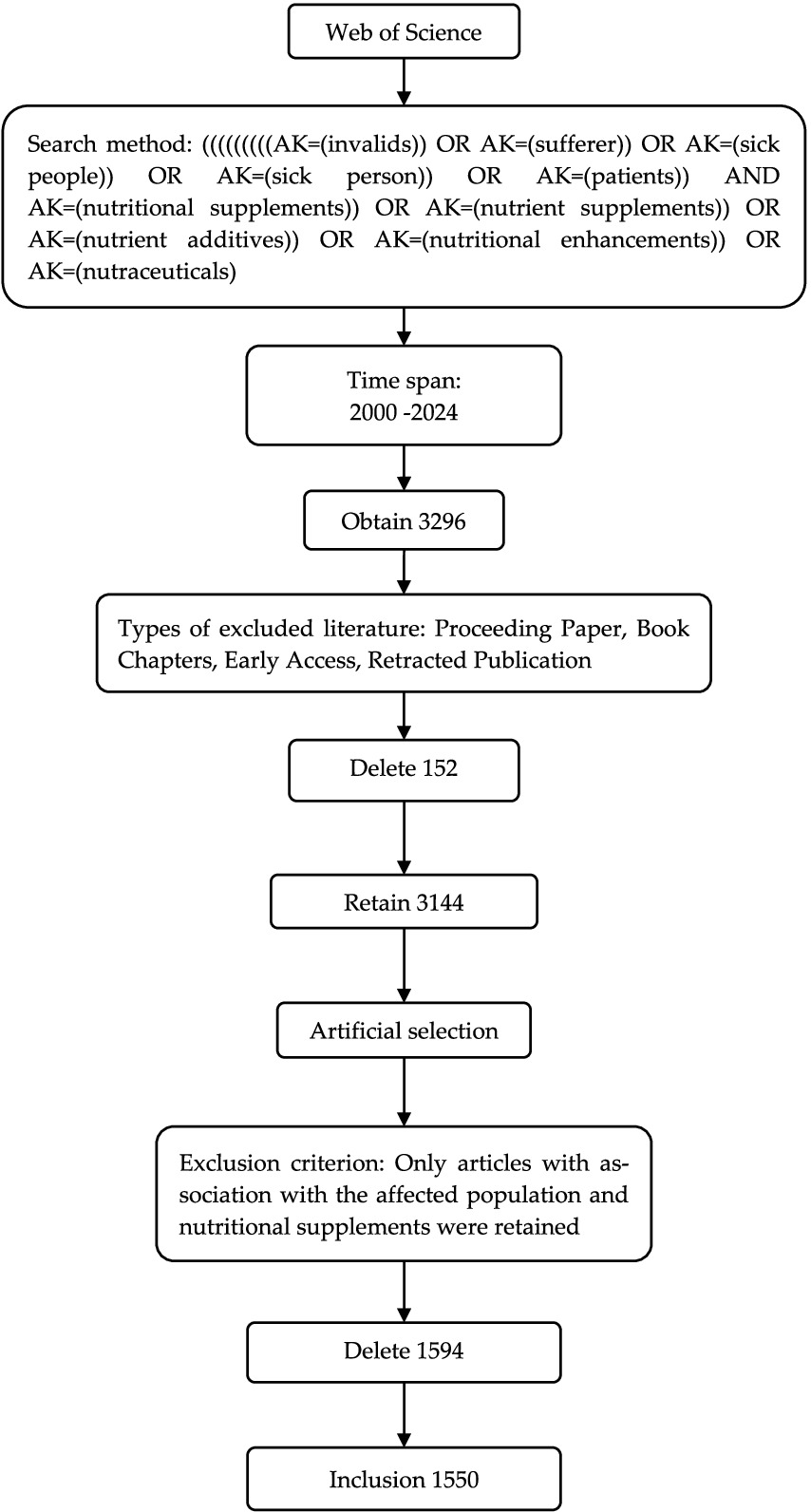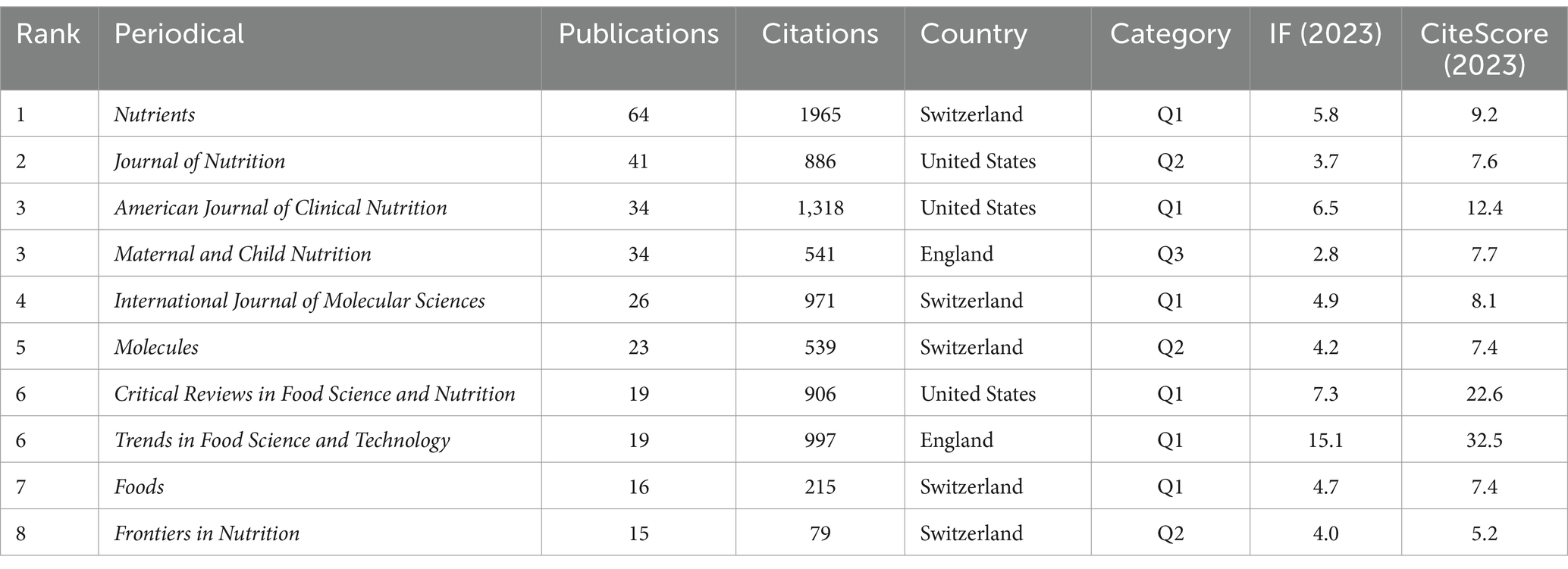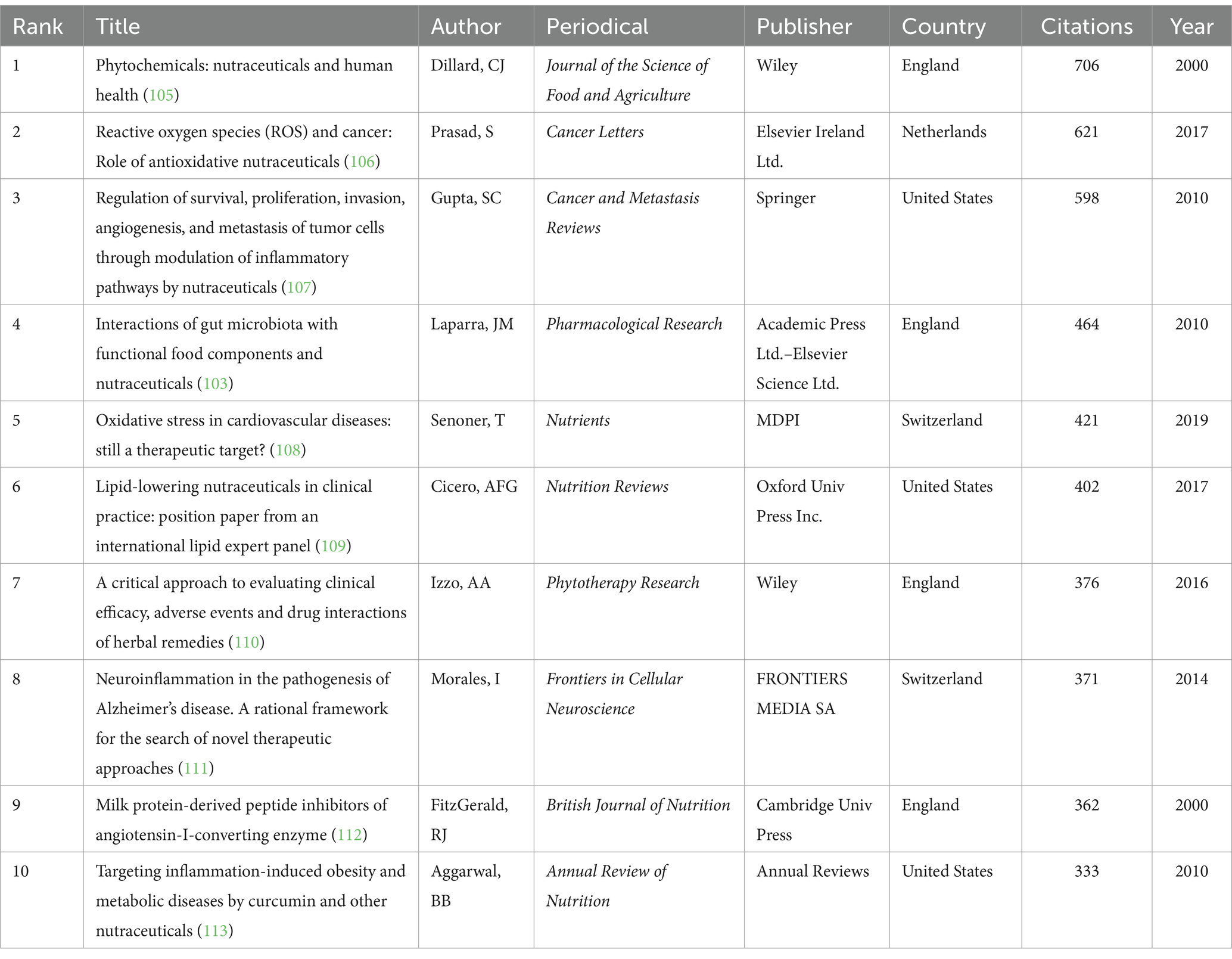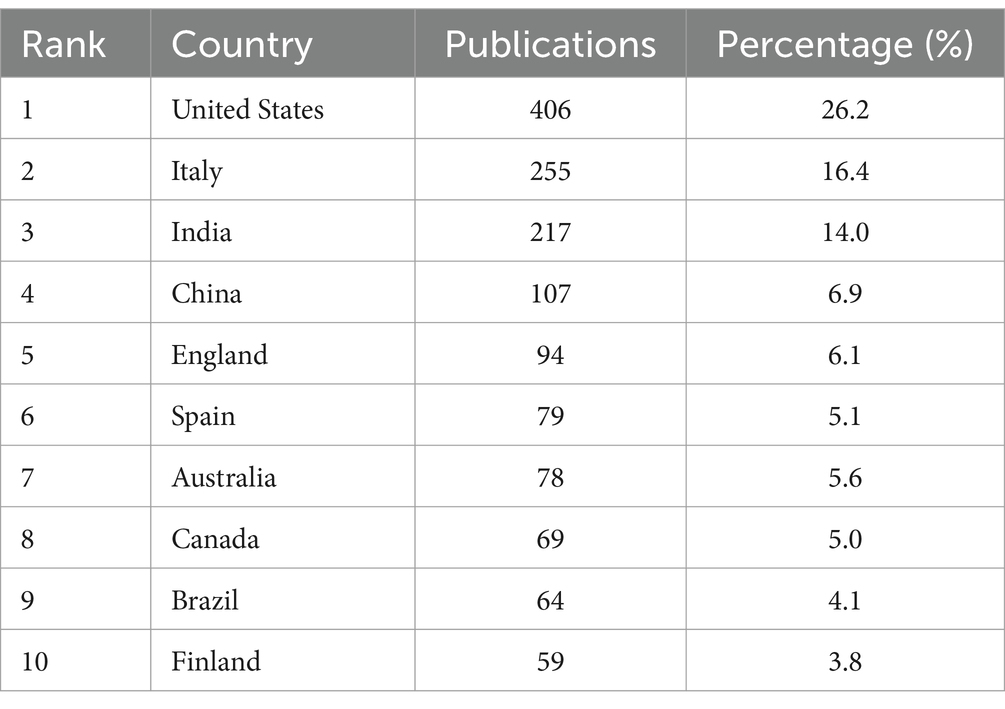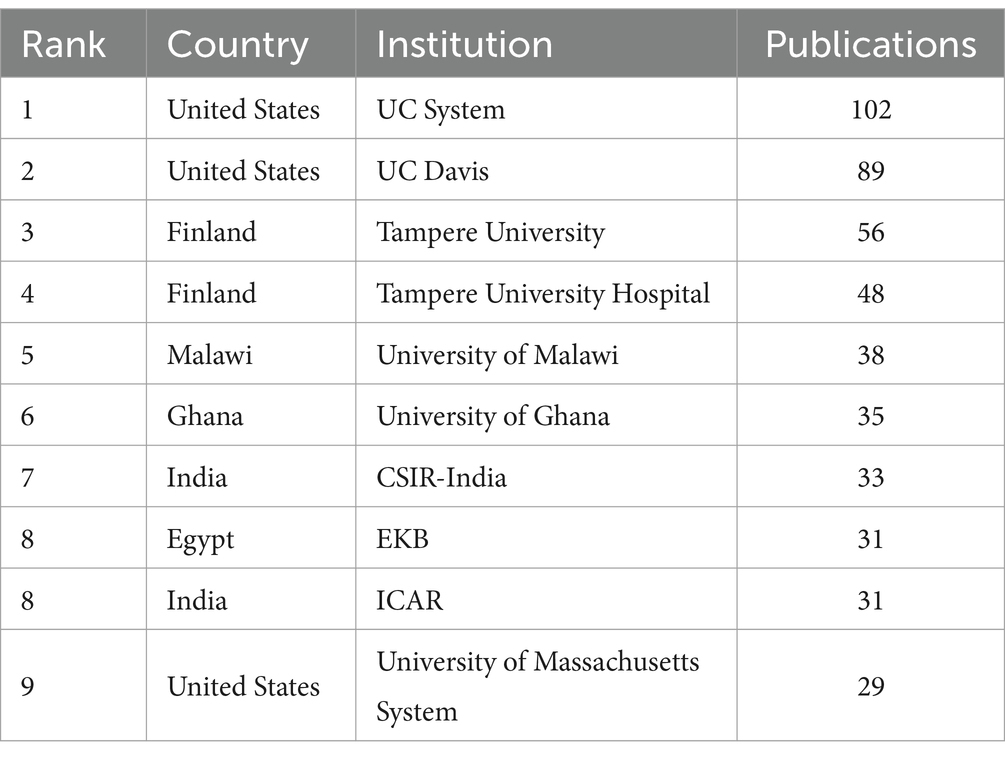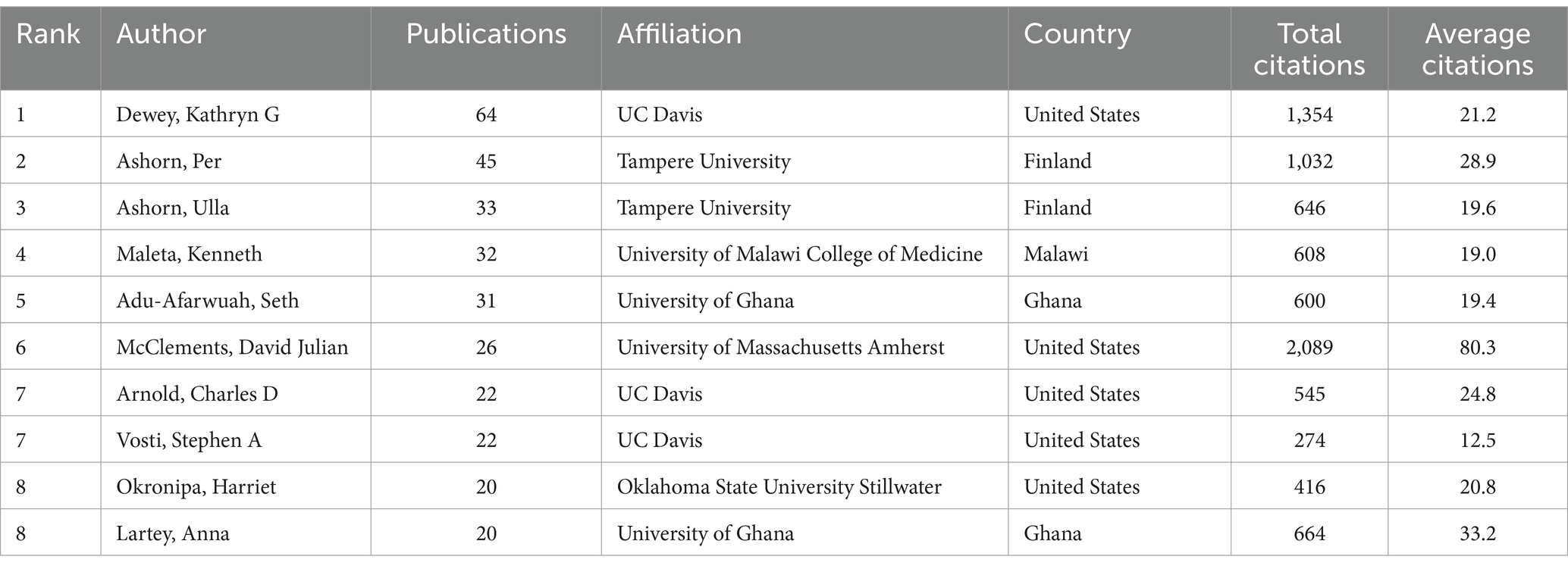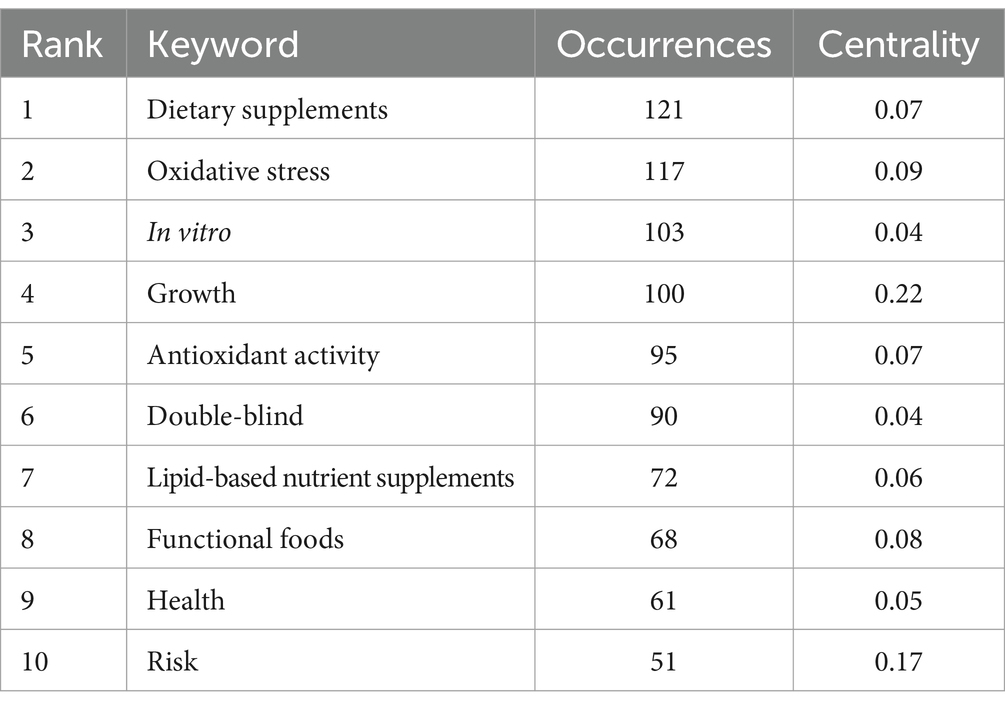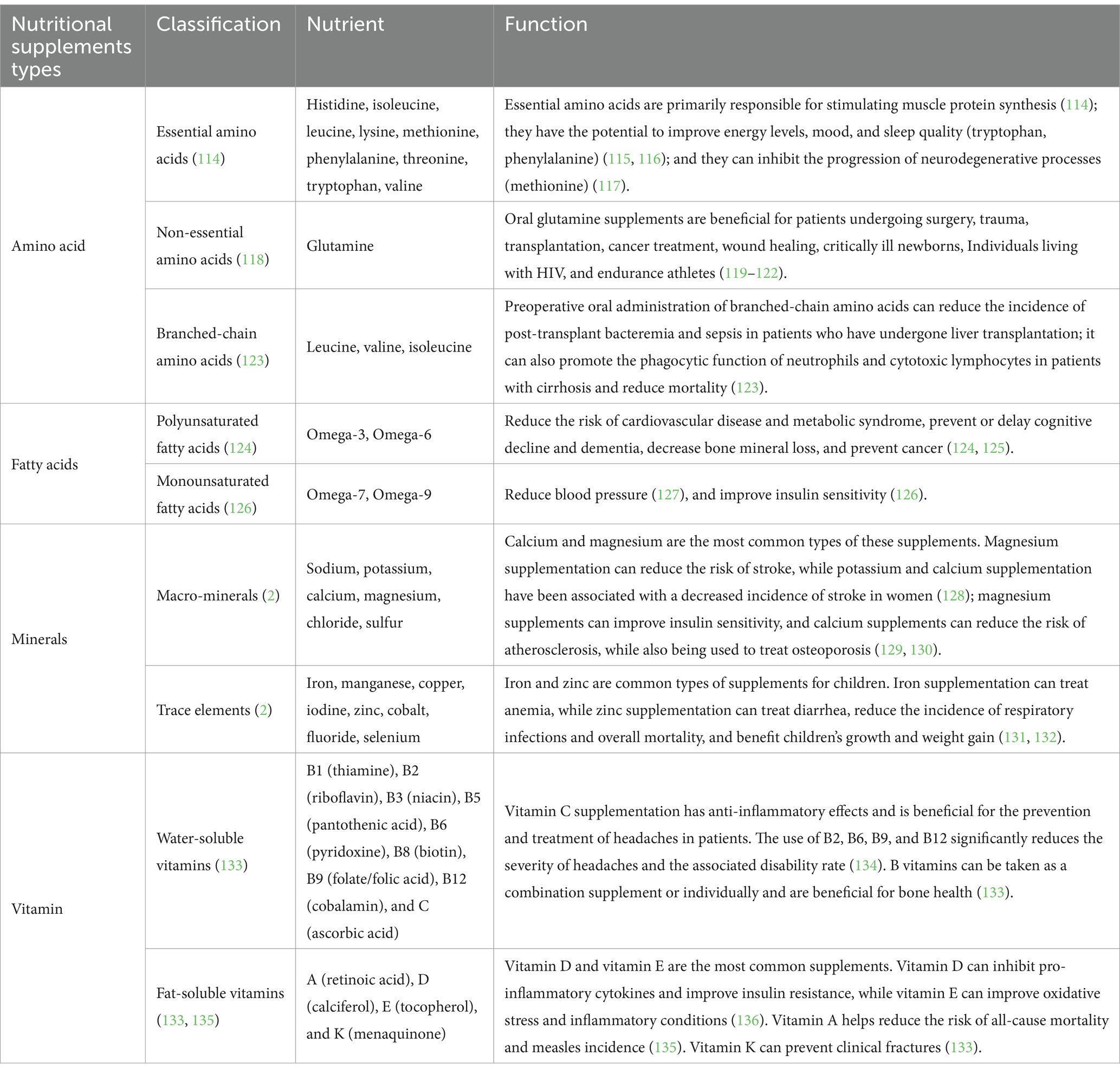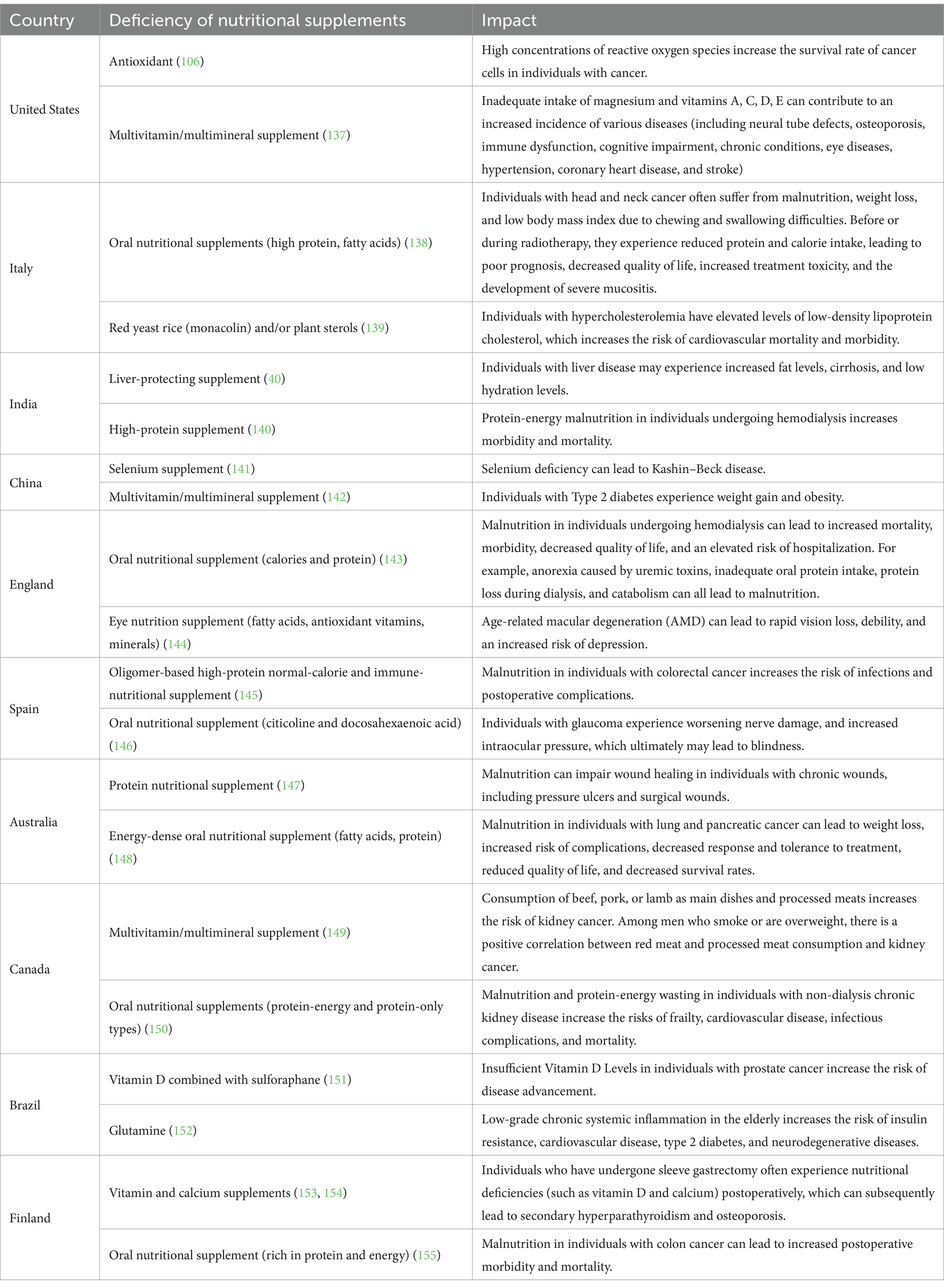- 1College of Physical Education, Henan University, Kaifeng, Henan, China
- 2Research Center of Sports Reform and Development, Henan University, Kaifeng, Henan, China
- 3Institute of Physical Fitness and Health, Henan University, Kaifeng, Henan, China
Background: Nutritional supplements (NS) can help patients by providing various nutrients such as essential vitamins and minerals, helping to prevent and recover from diseases. This study provides a broad overview of the field of NS for sick people through bibliometrics and visualization analysis, to analyze the status and development dynamics, explore the popular research questions and directions, and reveal the development trends and research frontiers.
Methods: We searched the Web of Science Core Collection databases for literature related to NS for diseased populations from 2000 to 2024. A total of 1,550 articles were included in the analysis after screening. Analyses performed using CiteSpace and VOSviewer software.
Results: The field of NS for the sick population has witnessed an overall rapid growth in the number of publications, which is divided into three phases: 2000–2008 was the exploratory phase, 2009–2017 was the sustained development phase, and 2018 to date is in the rapid development phase. Research focuses on dietary supplementation, oxidative stress, in vitro injections, development, antioxidant activity, double-blind trials, lipid supplements, functional foods, the health of diseased populations, and the risks of NS.
Conclusion: Different supplements each possess unique benefits and should be chosen according to the type of disease to ensure they contain the corresponding nutrients. Vitamin supplements are widely mentioned among patient populations across the globe. Future trends may focus on applying nutritional supplements in gut microbiota and bioactive compounds. Researchers frequently mention the application of NS in women, infants, and children. It should continue to be monitored and optimized in the future to enhance its therapeutic effects, thereby accelerating patients’ recovery and improving their quality of life.
1 Introduction
Nutritional supplements (NS) contain one or more natural products, including herbs, vitamins, minerals, probiotics, amino acids, and fatty acids, among other nutrients, and are important when a person’s nutritional status is not conducive to good health (1, 2). The presence of malnutrition in a sick population is detrimental both physiologically and clinically, impairing quality of life and delaying recovery from the disease (3), and data suggest that disease-related malnutrition doubles the risk of death in hospitalized patients and triples the mortality rate of older adult patients in the hospital and after discharge (4). Nutritional support can be given orally, as well as enteral nutrition (tube feeding) and parenteral nutrition (5). Oral NS (ONS) is used for specific medical purposes to increase energy and nutrient intake, which is economical, convenient, and readily accepted by patients (6). ONS are liquid foods which are also used to improve nutrient intake in older adults and patients with a variety of health and dietary problems. The importance of enteral nutrition and ONS as artificial means of nutritional support has been elaborated (7). In a variety of hospital and community-based patients, the use of ONS has been shown to improve energy and nutrient intake, increase body weight and functional outcomes, reduce mortality and complications, and shorten the length of stay in hospitalized patients when compared to routine clinical care (8). During radiotherapy, many individuals with esophageal cancer have difficulty consuming solid foods, and regular semi-liquid and liquid diets are unable to meet their target energy requirements (9). The use of ONS at this time can supplement energy and protein deficiencies in individuals with esophageal cancer, maintain and increase their weight, improve nutritional status, and enhance their quality of life (10). All these effects allow adequate nutritional intake in patients with insufficient food intake and reduce the complications associated with malnutrition (11).
A balanced diet is the primary source of the body’s vital nutritional needs, and nutritional deficiencies are usually associated with lower average daily body requirements, with consequent health problems; multivitamin and mineral (MVM) supplements help to fill in the gaps where the daily diet does not meet the body’s nutritional needs (12). In addition, these supplements help to prevent a wide range of diseases and are better tolerated without increasing the risk of death (13). The use of vitamin supplements helps to reduce the risk of myocardial infarction and cardiovascular disease in groups such as adults aged 45–75 years with no history of myocardial infarction and women aged 49–83 years with no history of cardiovascular disease (14). MVM in filling critical nutritional gaps has been found to prevent anemia, neural tube defects, and bone disease by providing enough folate, iron, vitamin B12, and vitamin D (15). In addition, it can also be beneficial in preventing cancer or delaying cataracts, as well as in cognitive performance (16). A supplement containing 120 mg of ascorbic acid, 30 mg of vitamin E, 6 mg of beta-carotene, 100 μg of selenium, and 20 mg of zinc reduced overall cancer incidence by 31% and mortality by 37% in men (45–60 years old) after being ingested consistently by patients for 7.5 years (17). In the study, high doses of 3 vitamins with antioxidant properties (500 mg/d vitamin C, 400 IU/d vitamin E, and 15 mg/d β-carotene) along with zinc (80 mg zinc oxide) significantly reduced the risk of ocular disease, lens clouding, and nuclear cataracts by 28, 16, and 25%, respectively (18, 19). An Australian randomized controlled trial (RCT) of supplementation that included about 50 vitamins, minerals, and herbs found that it improved contextual recognition memory in men aged 50–74 years (20). Nutritional supplementation can positively affect the incidence of postoperative complications, especially in malnourished patients (21). The risks of malnutrition include a compromised immune system, increased incidence and severity of infections, poor wound healing, higher frequency of minor and serious complications, longer recovery time, longer hospitalization, and higher mortality (22). Studies have shown that 40–55% of hospitalized patients are malnourished or at risk of malnutrition, and the risk of malnutrition increases with age. Malnourished surgical patients are 2–3 times more likely to have complications and increased mortality than the general population (23). Thus, NS is of great significance for disease prevention and patient rehabilitation.
Bibliometrics is the discipline that quantifies bibliographic materials by analyzing research areas and identifying major trends (24). It includes the analysis of research topics, countries, journals, and institutions (25–28). In this paper, we searched for studies on NS in sick populations from 2000 to 2024. The aim is to find out the research hotspots and explore the development trend in NS for sick people, to quickly provide high-value information and promote the rapid development of research in this field.
2 Data collection and research methods
2.1 Data collection
In this study, the Web of Science Core Collection (WOSCC) database was used as the data source, and the period was set from January 1, 2000, to April 21, 2024. This paper was searched using the Author Keyword (AK) form with the search format [AK = (invalids)] OR [AK = (sufferer)] OR [AK = (sick people)] OR [AK = (sick person)] OR [AK = (patients)] AND [AK = (nutritional supplements)] OR [AK = (nutrient supplements)] OR [AK = (nutrient additives)] OR [AK = (nutritional enhancements)] OR [AK = (nutraceuticals)] search. The total number of articles was 3,296, excluding Proceeding Papers, Book Chapters, Early Access, Retracted Publication. After excluding 152 articles, 3,144 articles were left and were manually screened. Only articles relevant to diseased populations and NS were retained. We further excluded 1,594 articles, and 1,550 articles were selected (Figure 1).
2.2 Research methods
In this study, Citespace was used to analyze, detect, and visualize trends and patterns in the scientific literature (29), and VOSviewer was used to construct and view bibliometric maps (30). Citespace was used to map knowledge, and VOSviewer was used to construct and view bibliometric maps. Institutions, authors, keywords, and countries of 1,550 screened documents were visualized and analyzed, and the trend of the number of publications and maps of author collaboration, institutional collaboration, geographic distribution, and keyword were drawn to highlight key nodes and research hotspots and to visualize the field of NS for diseased populations, respectively.
3 Results
3.1 Annual volume of communications
A total of 1,550 relevant articles were published in this field from 2000 to 2024, and the overall trend of a sharp increase in the number of annual publications can be seen in Figure 2. The number of publications was relatively stable from 2000 to 2008, which increased per year from 2009 to 2017. There was a rapid increase in the number of publications after 2018 and up to 2023.
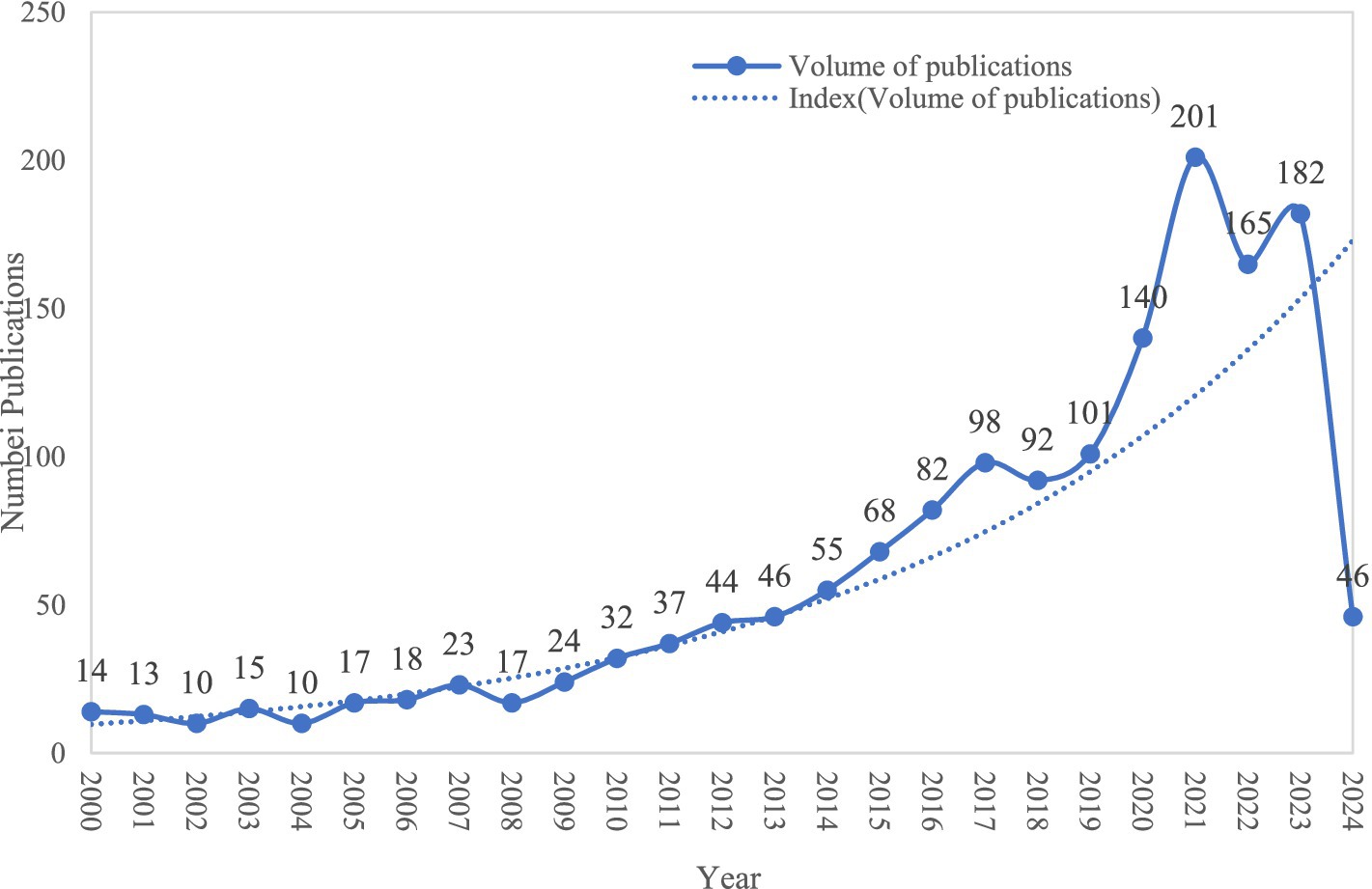
Figure 2. Trends in the number of publications per year. The solid blue line represents the annual variation in the number of publications, while the dashed blue line indicates the overall trend in publication volume.
3.2 Journal analysis
The top 10 journals that issued articles are shown in Table 1. Research on NS for sick people primarily involves nutritional, clinical, and nursing journals. The top 10 journals had a total of 291 articles, accounting for 18.8% of the total number of articles, indicating that these journals are the mainstay of research in this field and are in the lead. Nutrients, with 64 articles and a citation frequency of 1,965, ranked at the top in terms of both articles and high citations, indicating that the journal is of high quality and is more popular in the field. The second-ranked journal is the Journal of Nutrition, which has 41 articles. In third and fourth places are the American Journal of Clinical Nutrition and Maternal and Child Nutrition, with 34 articles each. Five of the top 10 journals are from Switzerland.
3.3 Analysis of highly cited literature
Among the top 10 cited literature (Table 2), “Phytochemicals: nutraceuticals and human health” by Dillard, CJ is the most highly cited article with 706 citations, which was published in 2000.
3.4 Analysis of countries/regions
Table 3 demonstrates that the United States is in 1st place in terms of the number of publications in this field, with a total of 406 publications, accounting for 26.2% of the approximate total. Italy ranks 2nd with 255 articles, accounting for about 16.4% of the total number of articles. India ranked 3rd with 217 articles, accounting for about 14% of the total. China ranked 4th with 107 articles, accounting for 6.9% of the total number of articles. The distribution charts (Figures 3, 4) show the cooperation relationship and density of each country. The size of the nodes in Figure 3 represents countries’ contribution, while the connecting lines between nodes indicate collaboration among nations. The thickness of the lines is positively correlated with the strength of the connection, and the color of the lines represents different clusters of countries engaging in spontaneous collaboration (31, 32). As shown in Figure 4, there are 108 nodes and 512 links; the network density is 0.0886. The size of the nodes is positively correlated with the number of articles published by the country. The lines represent the cooperative relationships between countries, and the number of lines positively correlates with the cooperation density (33, 34). Grid density evaluates the tightness of connections in a knowledge graph based on links and nodes. Indicating more cooperation in this field, close cooperation has been carried out mainly centering on the United States, Italy, India. Centrality is an important indicator for determining the evolution process of a discipline and predicting its development trends. The level of centrality represents the degree of importance to the development of the discipline (35). The centrality index of each country shows that some countries are at the top of the field in terms of the number of publications but have a centrality of 0, such as Mexico, Malawi, and Ghana. This indicates that the field is a hot topic of research within these countries, but there is no communication and cooperation with the outside world yet.
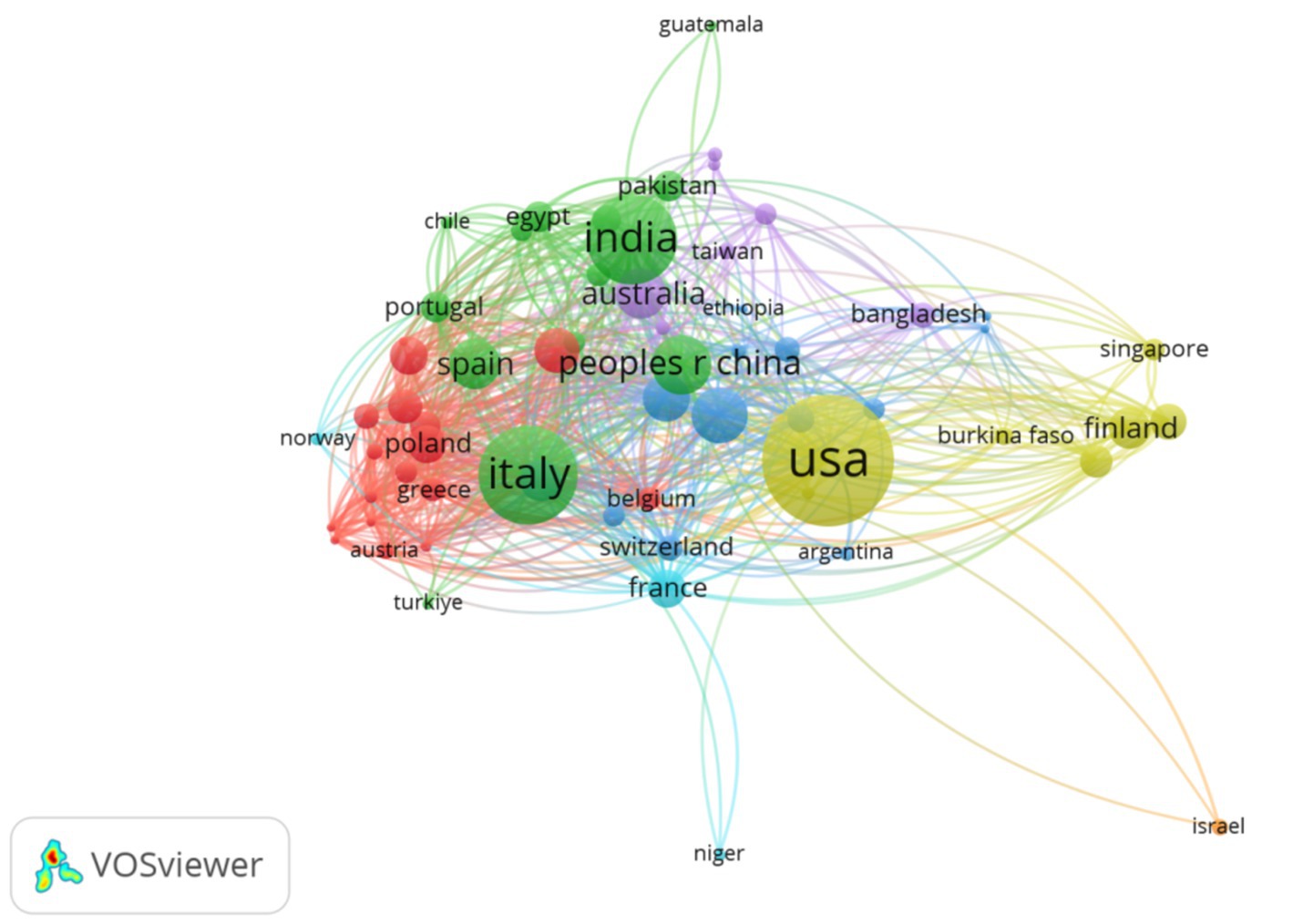
Figure 3. Distribution of publications by country region. The size of the nodes represents countries’ contributions, while the connecting lines between nodes indicate collaboration among nations. The thickness of the lines is positively correlated with the strength of the connection, and the color of the lines represents different clusters of countries engaging in spontaneous collaboration.
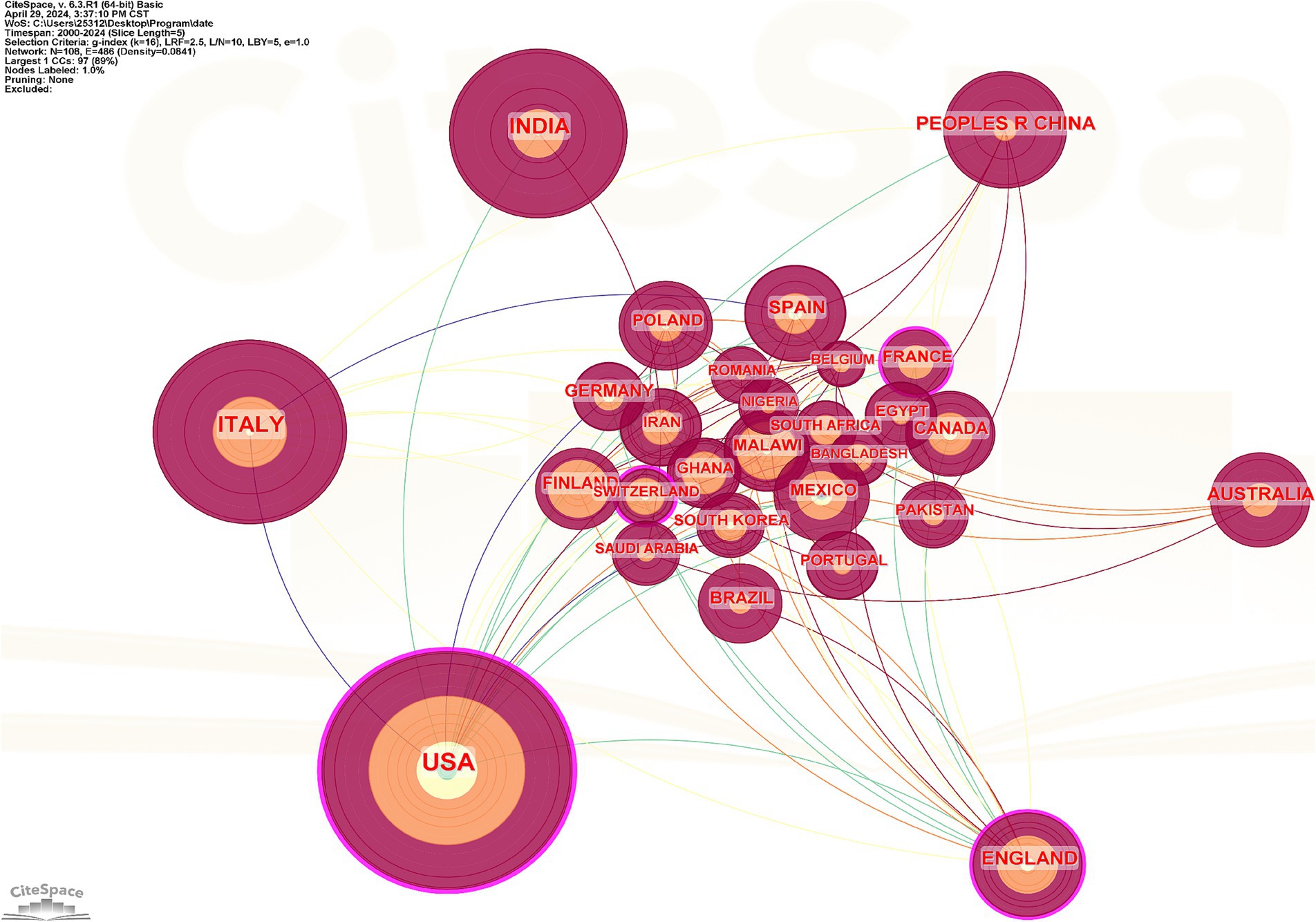
Figure 4. Distribution of national and regional distribution of publications. The size of the nodes is positively correlated with the number of articles published by each country. The lines represent the cooperative relationships between countries, and the number of lines positively correlates with the cooperation density.
3.5 Analysis of institutional and author collaboration
Figures 5, 6 show the partnership and collaboration density between institutions. Universities dominate the volume of institutional publications. The University of California (UC) System tops the list with 102 publications. The UC Davis is 2nd with 89 articles. Other influential institutions are Tampere University, Tampere University Hospital, University of Malawi, University of Ghana, Council of Scientific and Industrial Research (CSIR) – India, Egyptian Knowledge Bank (EKB), Indian Council of Agricultural Research (ICAR), and University of Massachusetts System. Among the top 10 institutions in terms of the number of publications, three are from the United States and two each from India and Finland (Table 4). This indicates that these countries emphasize the development of research in this field, and a greater demand for research results in this field may exist due to the large number of sick or chronically ill people in their countries.
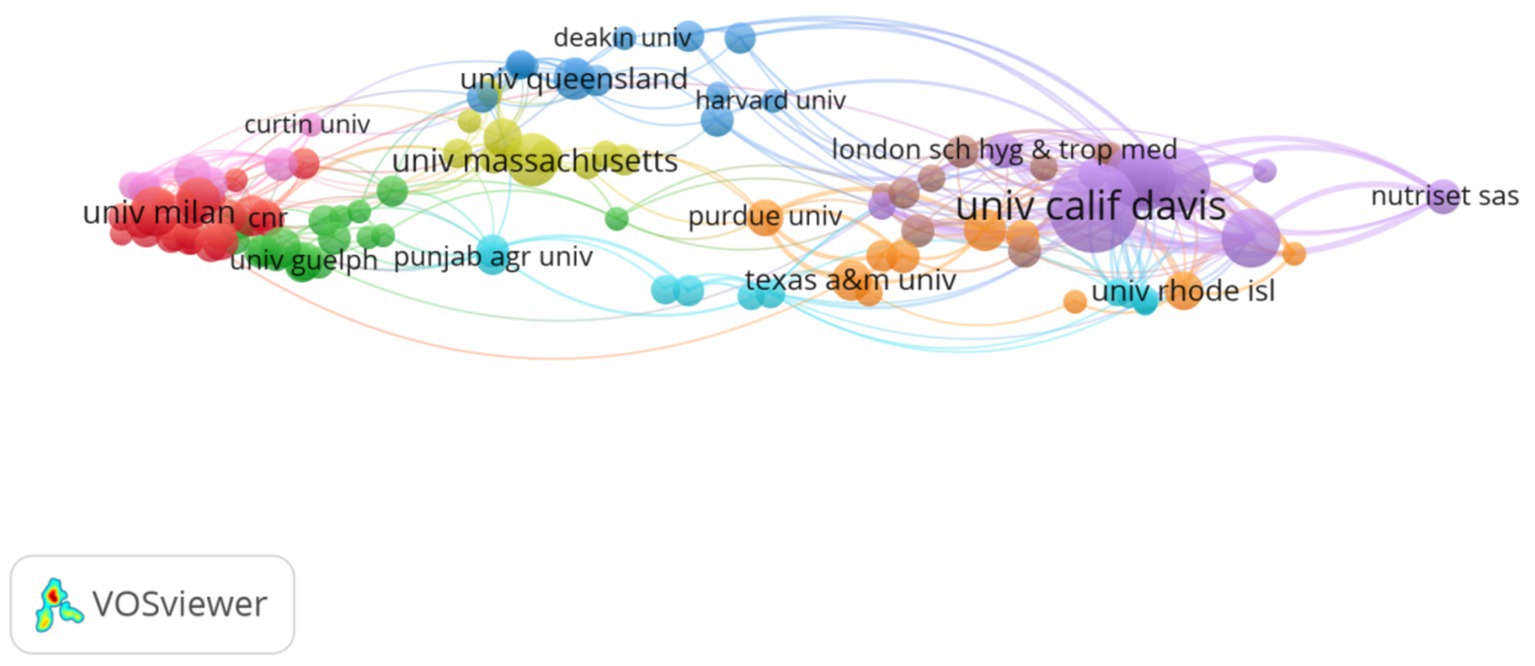
Figure 5. Collaborative mapping of research institutions. The size of the nodes is proportional to the publication volume of the institutions, while the thickness of the connecting lines indicates the strength of collaboration between the institutions. Different color clustering reflects the cooperative relationship between institutions.
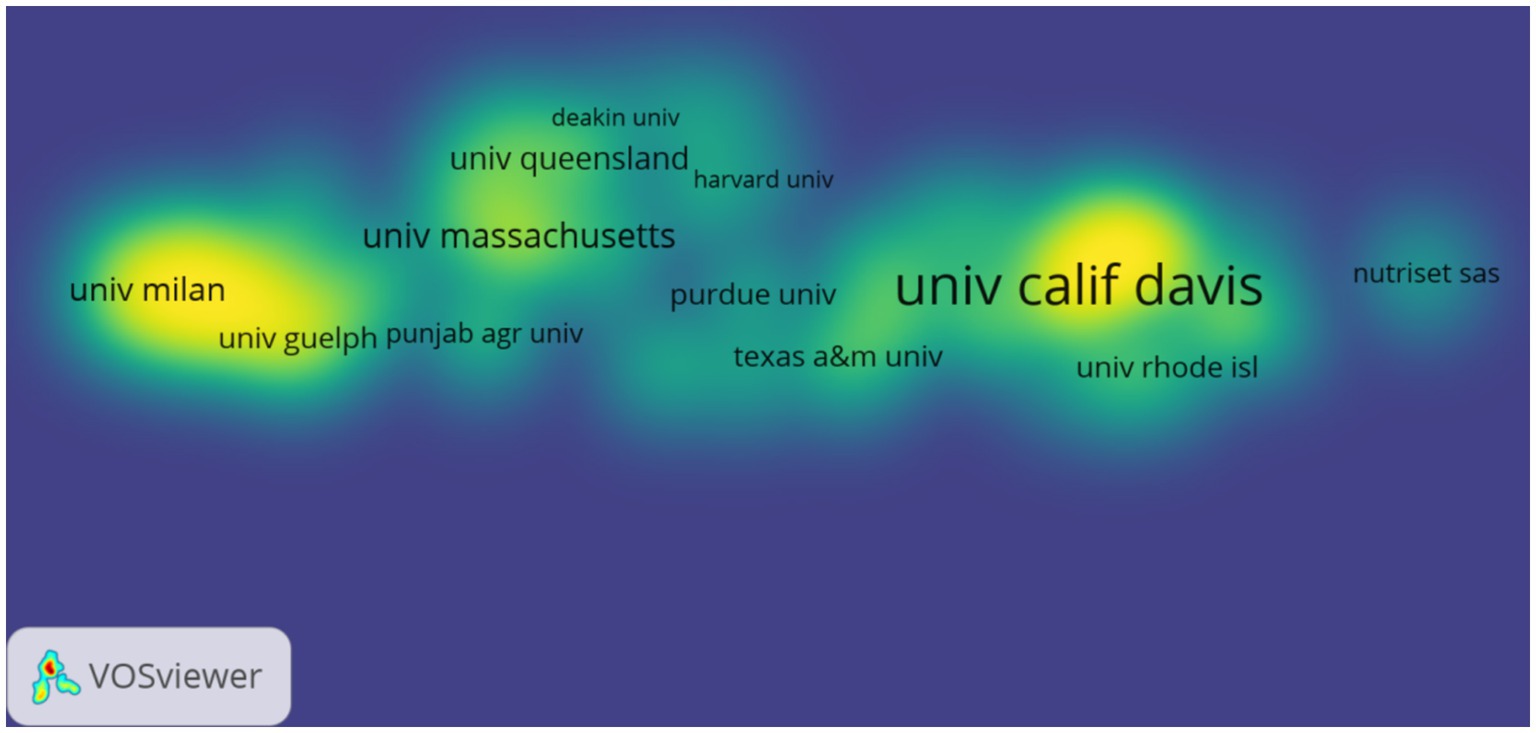
Figure 6. Density of cooperation among research institutions. The density of institutional cooperation is positively correlated with color expression: the higher the density, the more the color tends toward yellow and intensifies; when the density decreases, the color shifts toward the blue range.
In the author collaboration network mapping (Figure 7), the number of nodes and connecting lines, size, and co-occurrence frequency indicate the relationship and strength of collaboration between authors (36). In Figure 7, there are 227 nodes and 535 connecting lines, and the network density is 0.0209. Figure 7 shows that Dewey, Kathryn G., and Ashorn, Per are prolific authors in the field with high impact. As shown in Table 5, five of the top 10 authors in terms of publications are from the United States. The most highly cited author is McClements, David Julian, who is from the United States, with 2,089 citations. This author has a relatively small number of 26 publications, indicating a high quality of publications, which is favorable for scholars in this field to refer to and learn from.

Figure 7. Mapping of author collaboration networks. Each node signifies an author, while each line represents a collaborative partnership between two authors. The more lines there are, the closer the collaboration. The size of the author’s name is directly proportional to the number of their publications.
3.6 Analysis of research hotspots
3.6.1 Keyword co-occurrence analysis
There are 294 nodes and 1,205 connecting lines between the keywords, with a grid density of 0.028 (Figure 8). The most frequent keywords were “dietary supplements,” “oxidative stress,” “in vitro,” “growth,” “antioxidant activity,” and so on. Among the top 10 keywords in terms of repetition frequency (Table 6), two had a centrality over 0.1, namely “growth” (0.22) and “risk” (0.17). That is, both caused a great sensation in that year and were hot topics of research.
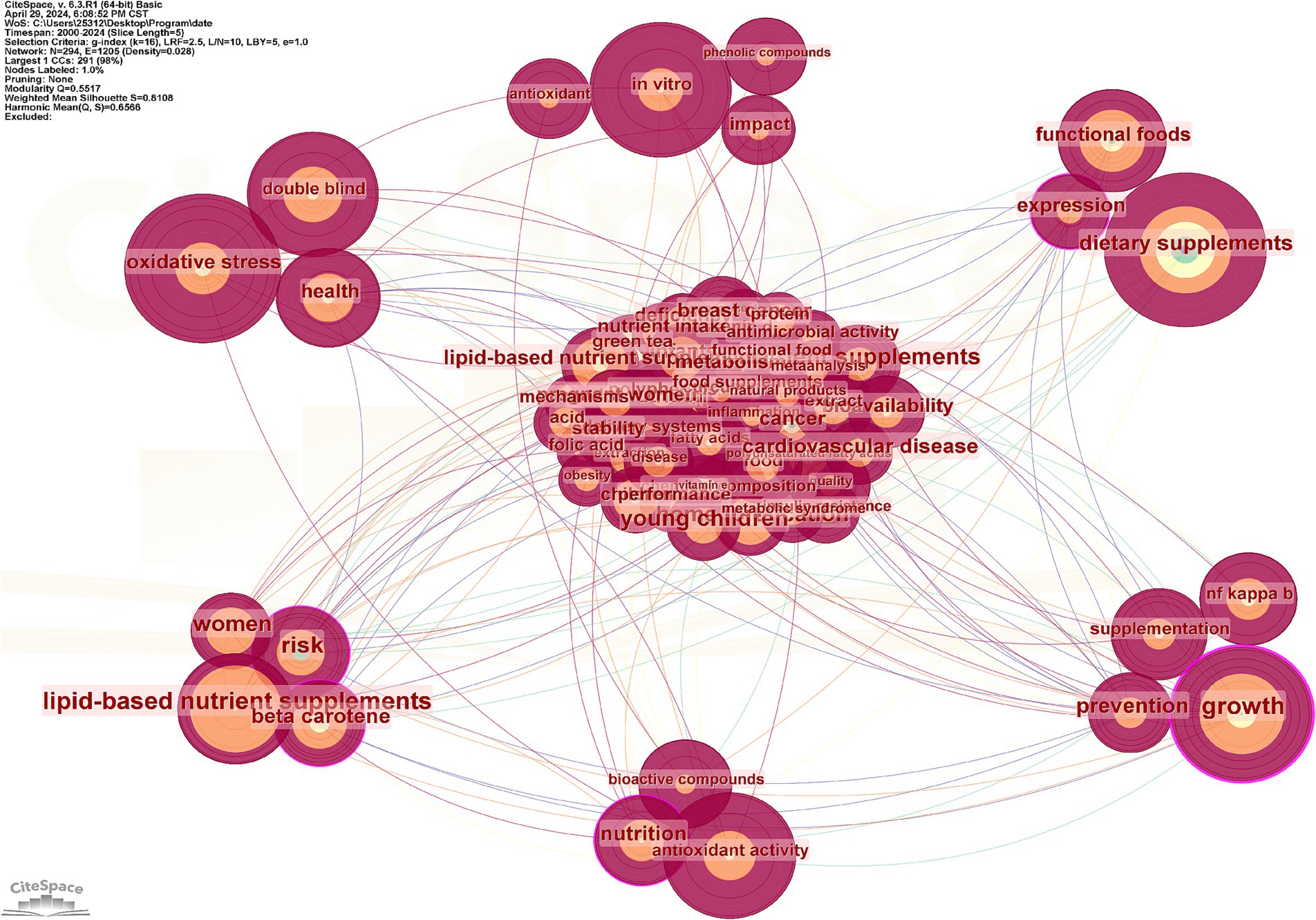
Figure 8. Keyword co-occurrence mapping. The size of nodes is positively correlated with the co-occurrence frequency of keywords, meaning that higher frequency results in larger nodes. The lines represent the co-occurrence relationships between keywords, indicating that these keywords have appeared together in the same literature. Purple circles denote nodes with a centrality greater than 1, and the thickness of these purple circles is proportional to their centrality level; the higher the centrality, the thicker the circle.
3.6.2 Keyword highlighting analysis
In Figure 9, “strength” represents the burst intensity of keywords, where a higher intensity indicates a deeper impact. The Begin and End points, corresponding to the red line, signify the start and end times of the popularity (37). The length of the red line indicates the duration of the popularity. The dark blue line represents that the topic has been mentioned less frequently by researchers and has not yet formed a research hotspot. The light blue line indicates that no scholars have yet been involved in the research on this topic, and it is still in its nascent stage (38). Keyword highlighting (Figure 9) shows that research on dietary-type supplements, functional foods, and the use of supplements in breast cancer began in 2000 and ended in 2014 as the longest-running hot topic in the field. Lipid nutritional supplement research initially appeared in 2011, with a surge in heat from 2011 to 2019, highlighting a higher intensity. Women and infants became the main subjects of research around 2015. From 2015 to 2024, the randomized controlled trial emerged as the most popular experimental method. Between 2020 and 2024, gut microbiota, bioactive compounds, and randomized controlled trials have seen the highest research heat and are likely to become future trends in development.
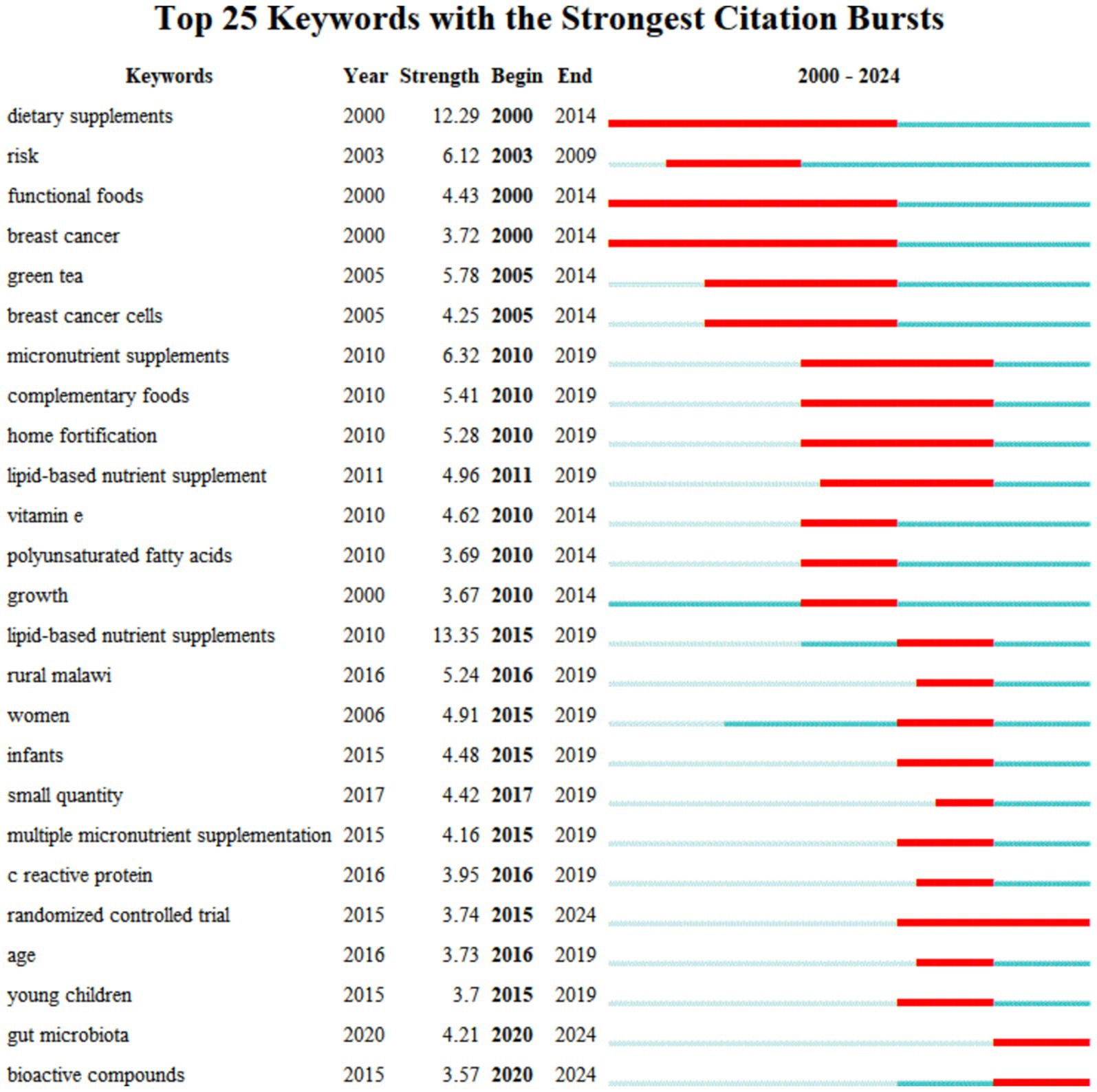
Figure 9. Keyword highlighting. “Strength” indicates the burst intensity of a keyword, with the intensity being directly proportional to its influence. Red lines represent a surge in the usage frequency of a keyword during a certain period, while dark blue lines indicate the opposite trend. The light blue line indicates that research related to this keyword has not yet commenced during that period.
3.6.3 Keyword clustering analysis
Keyword clustering can better represent the research hotspots in the field. In the clustering map, Q represents the module value, which indicates the structure of the clusters; S represents the average profile value, which indicates the clustering efficiency and rationality. Generally speaking, the Q value in the interval [0, 1], Q >0.3, means that the structure of the delineated associations is significant; when the S value is 0.7, the clustering is efficient and convincing, and if it is above 0.5, the clustering is generally regarded as reasonable (39). In this study, the Q value is 0.5517, which indicates that the clustering structure is quite significant, and the S value is 0.8108, which indicates that the clustering results are reasonable, efficient, and convincing (Figure 10). The larger clusters were #0 nutraceuticals, #1 dietary supplements, #2 lipid-based nutrient supplements, #3 inflammation, #4 feed additives, #5 bioavailability, and #6 nutritional enhancement. Figure 11 demonstrates the evolution of keyword research hotspots from 2000 to 2024, in which the high-frequency keywords are primarily “nutraceuticals,” “dietary supplements,” “lipid-based nutrient supplements,” “inflammation,” “feed additives,” “bioavailability,” and “nutritional enhancement.” lipid-based NS and dietary supplementation have consistently informed research in the field. Developmental and dietary supplementation research was most popular around 2000; studies of oxidative stress, antioxidant sensitivity, and double-blind trials were hot topics at the time around 2007. Lipid-based NS and in vitro types of supplements gradually came to prominence in 2011. The number of hotspots saw a significant increase between 2015 and 2020, possibly due to technological advancements during that period.
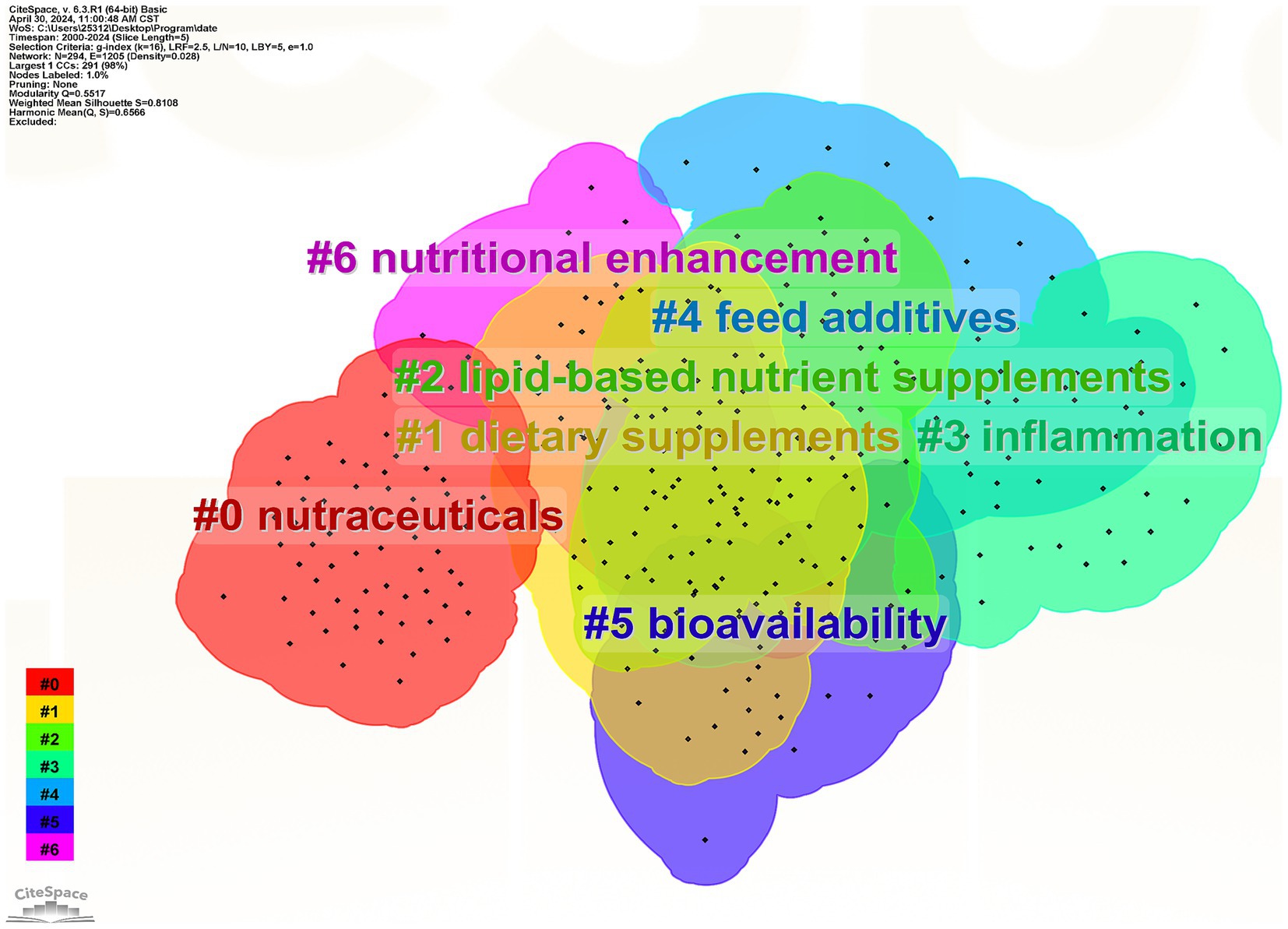
Figure 10. Keyword clustering mapping. Different clusters represent different topics, with nodes of the same color located within the same cluster indicating that they share the same topic. A smaller cluster label number signifies a cluster that contains more keywords, whereas a larger number indicates the opposite.
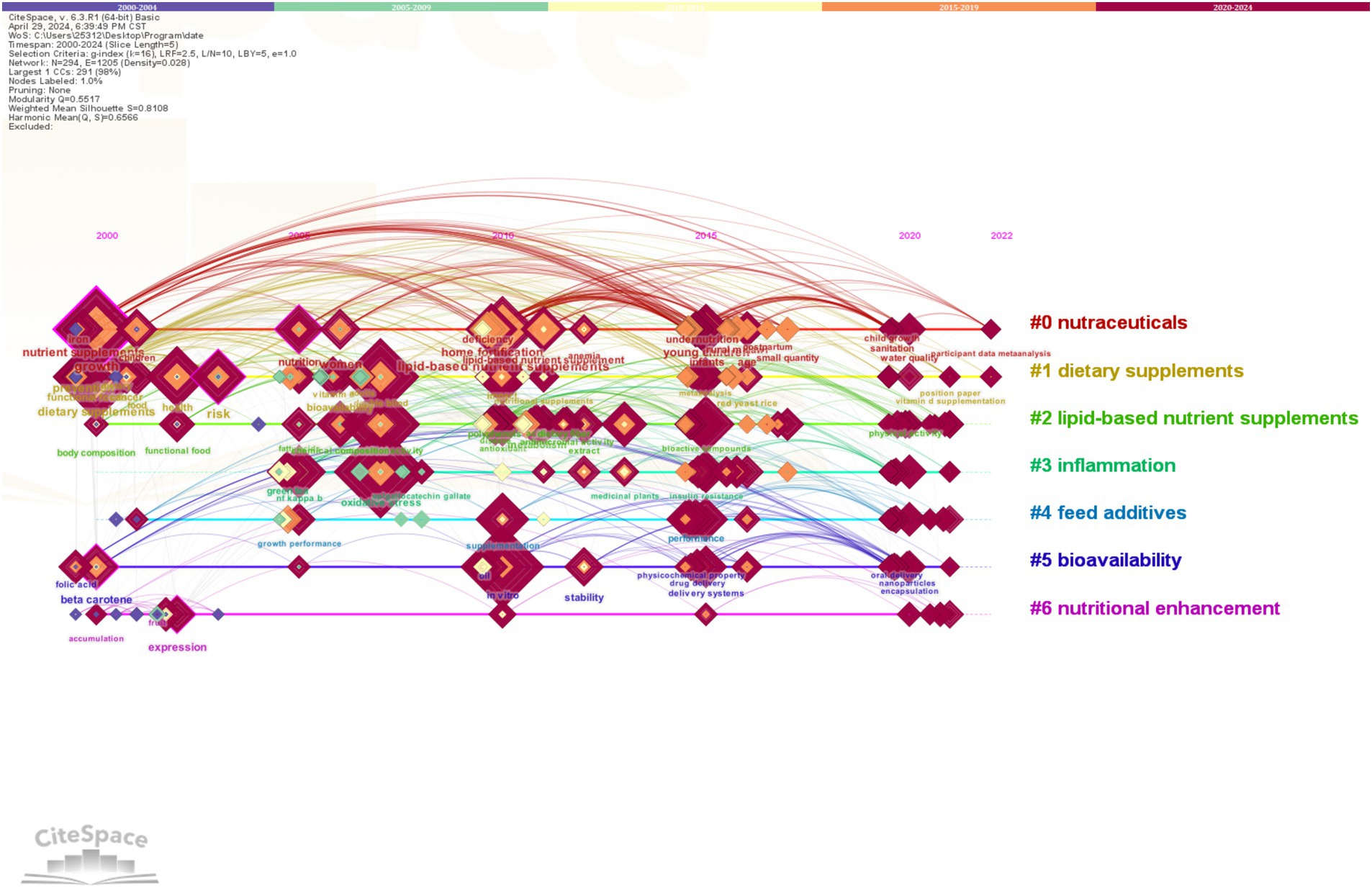
Figure 11. Keyword time zone mapping. Each horizontal line represents a cluster, and the square nodes on the line indicate keywords with higher frequencies of occurrence. The timeline is located at the top of the graph, and the year corresponding to each node represents the time of publication. The lines connecting the nodes reflect their co-occurrence relationships.
3.7 Types functions and effects of nutritional supplements
Table 7 presents the types of supplements (2), the categories of nutrients, and their roles in various diseases. Table 7 shows four significant categories of supplements: amino acids, fatty acids, minerals, and vitamins. Amino acid supplements primarily function to provide additional amino acids, promote protein synthesis, maintain normal bodily functions, enhance immunity, promote muscle growth and recovery, and help regulate nerve function and improve sleep. Fatty acid supplements improve cardiovascular and cerebrovascular health, regulate the immune system, and promote brain function. Mineral supplements primarily maintain bone health, metabolic balance, and the normal functioning of various physiological processes. Vitamin supplements mainly strengthen the immune system, support metabolic processes, and keep the normal functioning of organs such as the skin and eyes. Table 8 demonstrates the impact of NS deficiencies on patient populations in the top 10 countries with the highest publication volume. Vitamin supplements are frequently mentioned in the United States, China, the United Kingdom, Canada, Brazil, and Finland. Cancer has the widest variety of NS types. ONS is used in multiple countries, with different ONS containing various nutrient types corresponding to other diseases. For example, in Italy, high-protein, high-fat ONS are used for individuals with head and neck cancer. ONS containing choline phosphate and docosahexaenoic acid are used for patients undergoing hemodialysis in Spain.
4 Discussion
Nutritional supplements are used as products intended to provide essential nutrients that may be lacking in sufficient quantities in the human diet (40). However, a significant number of patients do not know what an NS is and its function and consider it a drug. This may mislead patients into believing that supplements are as safe and effective as drugs and that drugs are studied in the same way as NS (41). The current use of NS is not standardized, and a large percentage of people do not consider the opinions of healthcare professionals who believe that what is naturally made is safe and effective. For example, in the United States, less than a quarter of NS is recommended by a physician or medical professional (42). A non-randomized observational trial of postmenopausal women showed a significant 6% increase in mortality in women taking MVM (43). In a Swedish population-based cohort study of men aged 45–79 years, the use of high-dose vitamin C or E supplements was associated with an increased incidence of age-related cataracts. This shows that although NS has an important role to play in disease prevention or recovery, it should be tailored for consumers according to their age, gender, family history/risk factors, and stage of life (including reproductive age and old age) (16). Therefore, this paper compiles the research hotspots and dynamics in this field, which can help people quickly understand the relevant general knowledge and knowledge in this field and promote the use of NS for sick people to be more rationalized and standardized.
The trend of the annual number of papers can reflect the development speed and research heat of this research field in a certain period. Through the statistics of the annual number of papers, we can grasp the development stage and change trend (44). The research on NS for diseased populations in the past 20 years has been divided into three main phases. The number of papers issued from 2000 to 2008 was at a steady stage, and the research was primarily carried out in the direction of functional foods, antioxidants, dietary supplements, anthocyanins, and so on. Mazza, G was the more influential author in this period, who was primarily engaged in the research on the extraction of nutrients from plants for the prevention and treatment of diseases. Lacquer tree includes more than 250 species of flowering plants, and its extracts are known for their antibacterial, antifungal, and antiviral activities (45), which can be used for the treatment of bacterial diseases such as syphilis, gonorrhea, dysentery, and gangrene (46). This author optimized the extraction of phenolic compounds from berries, which are known to reduce coronary heart disease, prevent many types of cancers, and treat urinary tract disorders, as well as anti-inflammatory and antioxidant activities. Anthocyanins are the main phenolic constituents of berries and are twice as effective as commercially available antioxidants such as BHA and α-tocopherol (47). The 2009–2017 period has been characterized by a continuous growth in the number of publications, which is the accumulation phase of the field. This period was dominated by studies on oxidative stress, NS during development, and lipid NS. The results showed that lipid NS (LNS) are usually made from vegetable oils, milk powder, peanut butter, sugar, and a variety of micronutrients (48). There are various formulations of LNS, such as small-quantity LNS (SQ-LNS), used for preventing malnutrition and promoting growth and development (49). Studies during this period found that providing LNS-containing milk might promote growth from infancy to childhood (50). After 2018, the number of publications increased dramatically, and the field entered a phase of rapid growth. Studies on oxidative stress, in vitro nutritional supplementation, and antioxidant activity were mainly conducted during this period. Studies have shown that polyphenols, which are low molecular weight compounds present in seeds, flowers, and fruits, have antioxidant properties (51–53). Phenolic compounds are present in red wine, and proper daily consumption of red wine can reduce oxidative stress and inflammation, which can be beneficial in preventing coronary heart disease (54, 55). In the last two decades of research in this field, experiments and tests are often conducted using double-blind experiments and RCTs. Double-blind trials are designed to reduce the influence of potential bias on peer review in the pursuit of objectivity and fairness (56). RCTs are a major factor in the rapid development of medical science, marking the development and refinement of clinical research methods (57). This methodology plays a key role in modern clinical research and is important for the level of evidence in evidence-based medicine (58).
Nutrients ranks first in terms of the number of articles published and the frequency of citations, with a total of 64 articles published and 1,965 citations. It shows that this journal has a large influence in the field, and the quality of articles is high, with strong academic value and status. In the past two decades, the number of articles published by this journal has been on a steep rise; the number of articles published in 2019 surged, and the overall growth trend remained unabated until 2023. The journal covers a wide area of NS research, focusing on oxidative stress, dietary supplements, inflammation, chronic kidney disease, muscle mass, and vitamin D. The results show that adequate nutritional intake is essential for developing a healthy diet, addressing surgical stress, and mitigating the loss of muscle mass, strength, and function. Emphasizing protein intake during surgery, especially after surgery, can reduce muscle catabolism, resulting in loss of function (59). Egg white contains all the essential amino acids needed and has many beneficial effects on the body, and supplementation of an egg white-formulated diet is expected to improve nutritional status and increase serum albumin levels (60). Oxidative stress has been found to activate inflammatory pathways and enhance oxidative stress, which can accelerate the progression of metabolic diseases (59, 60). However, antioxidants such as polyphenols and resveratrol, along with vitamins C and E, can alleviate oxidative stress in metabolic disorders by enhancing the body’s natural antioxidant defenses and reducing reactive carbon production (61, 62). The journal also conducted a study on whether biological supplements are effective in improving the prognosis of People with kidney disease. Chronic kidney disease is associated with high morbidity and mortality, and its global prevalence is estimated to be around 13.4%. Previous meta-analyses have found that ONS improves the nutritional status of People undergoing long-term dialysis and may reduce complications (63, 64). A related study found a significant improvement in residual renal function in People with Parkinson’s disease 6 months after intervening with probiotic supplementation (65). Vitamins are active hormones in the liver and kidneys (66), and they are classical regulators of calcium and bone metabolism. Among its classical endocrine functions, vitamin D regulates mineral metabolism (67). Combining vitamin D supplements with protein supplements and exercise has been shown to increase patients’ grip strength and has also shown a tendency to increase muscle mass (68). Vitamin D (alone or in combination therapy) is effective in enhancing muscle strength and function in older adults (67, 68). “Methylsulfonylmethane (MSM): Applications and Safety of a Novel Dietary Supplement” was the most cited article in the journal. The article noted that MSM has become a popular dietary supplement that improves a variety of health-specific outcome metrics, including inflammation, joint/muscle pain, oxidative stress, and antioxidant capacity (69).
“Phytochemicals: nutraceuticals and human health,” the most cited article, focuses on research conducted on whether phytoconstituents can be incorporated as NS based on their ability to protect and promote health. Studies have shown three main groups of phytochemicals, namely terpenoids, phenolic metabolites, and alkaloids, and other nitrogenous plant constituents (70). The “new” nutraceuticals of plant origin may evolve into an important aspect of disease-preventive food composition (71).
In the global field of nutritional supplementation for sick populations, the top institutions are conducting research in the following directions: (1) The UC System in the United States focuses on lipid supplements and developmental research, primarily on children and women. The results show that lipid supplements provide micronutrients and key macronutrients (including fatty acids) (72) and can enhance the amount of micronutrients needed during pregnancy and lactation. Lipid supplementation during pregnancy (LNS-PL) also reduced neonatal growth retardation, wasting, and microcephaly in the study population (73). (2) The UC Davis and the UC System are similarly oriented in terms of the populations that they address, which are mostly women and children. We found that the top highly cited article was also from UC Davis. The study showed that prenatal and postnatal provision of SQ-LNS may be effective in improving linear growth in children (74). (3) The University of Tampere, Finland, focuses on LNS, development, and malnutrition and caters to a population of infants and children. The results showed that in women, prenatal supplementation with SQ-LNS promoted an increase in infant birth weight and height, as well as a decrease in the prevalence of Small for Gestational Age and neonatal growth retardation (75). The addition of SQ-LNS to the complementary diet of children aged 6–23 months may improve growth and anemia and may be more effective than other alternatives in improving growth (76). (4) The University Hospital of Tampere from Finland is like the University of Tampere study in that both have conducted research on lipid supplements, development, and so on and have dealt with infants and children. They work closely together, and the articles are closely linked. (5) The University of Malawi from Malawi focuses on lipid supplements, development, and malnutrition. Most of the populations targeted were infants, children, and women. Results showed that 12 months of dietary supplementation with LNS promoted linear growth and reduced the incidence of severe growth retardation in rural Malawian infants and young children (77). Another study indicated that the intake of LNS containing milk and soy had little impact on the participants’ linear growth and incidence of severe growth retardation, but certain antinutrients such as enzyme inhibitors, phytates, and lectins could potentially exert negative effects on linear growth (78).
The research and views of the team of highly productive and highly cited authors in the field of NS for diseased populations are shown as follows: (1) The Dewey, KG team from the United States primarily engages in research on LNS. The target population is primarily infants, women, and children. The results showed that SQ-LNS did not reduce depressive symptoms in Ghanaian women at 6 months postpartum (79) but increased plasma selenium concentrations in pregnant women (80). Nutrition-focused healthcare quality improvement reduces healthcare costs for patients and provides a high-value medication guideline for malnourished hospitalized populations (81). (2) The team of Ashorn, Per from Finland found that the provision of SQ-LNS reduced the prevalence of anemia (Hb < 110 g/L) by 16% (a relative reduction) and could significantly reduce childhood anemia, iron deficiency, and iron deficiency anemia (82). (3) The team of Ashorn, Ulla from Finland found that SQ-LNS supplementation in children aged 6–18 months led to earlier independent walking and waving goodbye (83). (4) The team of Maleta, K from Malawi found that the provision of iron-containing LNS to infants and young children for 12 months did not increase the prevalence of infectious diseases (84). (5) The team of Adu-AFNS from Ghana found that the provision of SQ-LNS to infants and young children did not increase the prevalence of infectious diseases (85). Adu-Afarwuah et al. (86) from Ghana found that antenatal supplementation with LNS improved fetal growth in vulnerable women in Ghana, especially primiparous women.
In the field of NS, dietary and lipid supplements are used most frequently and belong to the core types of the field. They are primarily used in People with cancer, patients with malnutrition, women, and children (87–89). Malnutrition may be due to personal, environmental, and food factors, such as individuals who are more sensitive to cholecystokinin (which suppresses appetite) experiencing faster satiety (90). The rate of glucose release in response to food may also affect appetite (91). The probability of being underweight is as high as 12.5% among community-dwelling People with chronic illnesses (92). The average prevalence of underweight in patients admitted to hospitals has been estimated to be about 18% (range 5–37.5%) (93). On average, patients with nutritional risk have a 19% higher hospitalization cost than at-risk patients with similar diagnoses (94). Providing nutritional support to patients with malnutrition can reduce the rate of postoperative complications by 10%, as well as save healthcare costs and reduce hospitalization time (95). Oral nutritional interventions given to people with cancer who are malnourished or at nutritional risk can be effective in increasing nutritional intake and improving quality of life (96). Gastrointestinal people with cancer and people without cancer both prefer the taste of fresh milk-based supplements (97). Dietary supplements, functional foods, and breast cancer were highlighted with higher intensity around 2000–2015, which was the dominant direction of research at that time. The results showed that patients with and survivors of breast cancer often use complementary and integrative therapies (98) and that breast cancer treatment could be improved by complementary dietary supplements (99). Studies during this period found that dietary bioactive compounds from different functional foods, including herbs and nutraceuticals (ginseng, ginkgo, nuts, grains, tomatoes, soy phytoestrogens, curcumin, melatonin, polyphenols, antioxidant vitamins, carnitine, carnosine, myostatin, ubiquinone, etc.) could improve health and prevent chronic diseases associated with aging, such as promoting antioxidant activity, mitochondrial stabilization function, metal chelating activity, inhibition of apoptosis in important cells and induction of apoptosis in cancer cells (100). In 2015, the field gradually shifted to research on multiple-micronutrient supplementation and lipid nutritional supplementation. Women, infants, and children became the focus of attention. It has been found that malnutrition (nutritional deficiency or obesity) in pregnant women can cause or exacerbate a large number of problems, such as anemia, maternal bleeding, insulin resistance, and hypertensive disorders, and also affects the normal development of the fetus during pregnancy (101). Supplementation with appropriate amounts of multiple micronutrients is beneficial in reducing the number of less-than-gestational-age children and maternal anemia (102). In 2020, the research direction gradually shifted toward the study of bioactive compounds and microbiota. The human gut contains a wide range of bacteria that have important metabolic and immune functions, and the gut microbiota produces metabolic activities that contribute to the digestion of dietary compounds, the rescue of energy, the provision of micronutrients, and the transformation of exogenous substances (103). Relevant researchers have found that healthy dietary patterns and supplements with bioactive compounds can be used as simple and easy interventions to prevent, mitigate, or cure clinical diseases, especially degenerative and chronic diseases (104).
In summary, the use of NS in diseased populations is very valuable. If used in the right way, type, and dosage, they will have unique benefits for prevention and rehabilitation and can reduce home healthcare costs, as well as the number of hospitalizations and days patients are hospitalized. However, the research on NS in the sick population is still one-sided; for example, the survey experiments are not sufficient to support the assessment of the effect of NS on the overall patient population. Risk assessment of the use of NS, its abuse in some populations without the guidance of healthcare professionals, clinical trials, and its effects on preoperative and postoperative periods in different populations are all issues that need to be improved in this field. Therefore, research on NS for sick people should continue, and the research efforts and regulations should be increased to solve and improve existing problems and promote the rational use of NS to help human society.
5 Limitations
In this paper, a bibliometric analysis of the field of NS for diseased people was conducted with the help of Citespace and VOSviewer. The use of visual mapping reveals more intuitively the trends and patterns in the field, which in turn derives a series of new findings and new interpretations. This study only selected the literature in the WOSCC database and did not include books and other databases; thus, the coverage of the selection is not sufficient to support the overview of the entire field. Furthermore, this study has certain limitations in selecting patient data between 2000 and 2024. Due to the scarcity of relevant literature before 2000, the study could not include data from that period for analysis, which may result in inadequate coverage of earlier research trends. However, since 2000, the number of related papers has increased significantly, providing abundant data sources and research support for this study. Nevertheless, this selection may still impact the historical continuity of the research conclusions. This paper focuses on the number of publications, journals, authors, institutions, keywords, and countries, aiming to provide a macro-analysis of the field; thus, some details are not reflected in the study, leading to a limited analysis of the literature. In this study, the search period was set to January 2000–April 2024, and articles after this period were excluded from the analysis list.
6 Conclusion
Findings show that the field of NS for sick populations has witnessed an overall rapid growth in the number of publications, which is divided into three phases. Subsequently, 2000–2008 was the exploratory phase, 2009–2017 was the sustained development phase, and 2018 to date is in the rapid development phase. The United States is the country with the highest number of publications in the world. The UC System in the United States is ranked as the leading institution in terms of the number of articles issued. Nutrients is the most published journal. Dewey, KG, is the most published author. The top highly cited article in the field is “Phytochemicals: nutraceuticals and human health.” Dietary supplementation, oxidative stress, in vitro injections, development, antioxidant activity, double-blind trials, LNS, functional foods, health of diseased populations, and risk of NS use are the top research topics in this field. Women and infants are the primary research subjects. Dietary-type supplements, functional foods, and supplement use in patients with breast cancer are the longest-running studies in the field. Different types of supplements each possess unique benefits, and should be chosen according to the type of disease to ensure they contain the corresponding nutrients. Vitamin supplements are widely mentioned among patient populations across the globe. Future trends in this area may focus on the application of nutritional supplements in gut microbiota and bioactive compounds.
Data availability statement
The original contributions presented in the study are included in the article/supplementary material, further inquiries can be directed to the corresponding author.
Author contributions
CS: Data curation, Formal analysis, Methodology, Software, Writing – original draft. HL: Conceptualization, Funding acquisition, Project administration, Software, Supervision, Writing – review & editing, Resources. TF: Formal analysis, Investigation, Methodology, Software, Writing – original draft. YL: Data curation, Resources, Software, Writing – original draft. HZ: Data curation, Investigation, Methodology, Software, Writing – original draft. FL: Methodology, Software, Validation, Writing – original draft, Writing – review & editing.
Funding
The author(s) declare that financial support was received for the research, authorship, and/or publication of this article. This study was supported by the Training Program for Young Core Teachers in Higher Education Institutions of Henan Province (2023GGJS023), Postgraduate Education Reform and Quality Improvement Project of Henan Province (YJS2025ZX32), Education and Teaching Reform Project in Higher Education of Henan Province (2024SJGLX0265), and Postgraduate Education Reform and Quality Improvement Project of Henan Province (YJS2025JC28).
Conflict of interest
The authors declare that the research was conducted in the absence of any commercial or financial relationships that could be construed as a potential conflict of interest.
Publisher’s note
All claims expressed in this article are solely those of the authors and do not necessarily represent those of their affiliated organizations, or those of the publisher, the editors and the reviewers. Any product that may be evaluated in this article, or claim that may be made by its manufacturer, is not guaranteed or endorsed by the publisher.
References
1. Mohty, R, Savani, M, Brissot, E, and Mohty, M. Nutritional supplements and complementary/alternative medications in patients with hematologic diseases and hematopoietic stem cell transplantation. Transplant Cell Ther. (2021) 27:467–73. doi: 10.1016/j.jtct.2021.03.011
2. Delompré, T, Guichard, E, Briand, L, and Salles, C. Taste perception of nutrients found in nutritional supplements: a review. Nutrients. (2019) 11:2050. doi: 10.3390/nu11092050
3. Stratton, RJ, and Elia, M. A review of reviews: a new look at the evidence for oral nutritional supplements in clinical practice. Clin Nutr. (2007) 2:5–23. doi: 10.1016/j.clnu.2007.04.004
4. Stratton, RJ, Bircher, G, Fouque, D, Stenvinkel, P, de Mutsert, R, Engfer, M, et al. Multinutrient oral supplements and tube feeding in maintenance dialysis: a systematic review and meta-analysis. Am J Kidney Dis Off J Natl Kidney Found. (2005) 46:387–405. doi: 10.1053/j.ajkd.2005.04.036
5. Wong, CS, and Aly, EH. The effects of enteral immunonutrition in upper gastrointestinal surgery: a systematic review and meta-analysis. Int J Surg. (2016) 29:137–50. doi: 10.1016/j.ijsu.2016.03.043
6. Arends, J, Bachmann, P, Baracos, V, Barthelemy, N, Bertz, H, Bozzetti, F, et al. ESPEN guidelines on nutrition in cancer patients. Clin Nutr. (2017) 36:11–48. doi: 10.1016/j.clnu.2016.07.015
7. Ishikawa, Y, and Sattler, ELP. Nutrition as treatment modality in heart failure. Curr Atheroscler Rep. (2021) 23:13. doi: 10.1007/s11883-021-00908-5
8. Schuetz, P, Seres, D, Lobo, DN, Gomes, F, Kaegi-Braun, N, and Stanga, Z. Management of disease-related malnutrition for patients being treated in hospital. Lancet Lond Engl. (2021) 398:1927–38. doi: 10.1016/S0140-6736(21)01451-3
9. Vasson, M-P, Talvas, J, Perche, O, Dillies, A-F, Bachmann, P, Pezet, D, et al. Immunonutrition improves functional capacities in head and neck and esophageal cancer patients undergoing radiochemotherapy: a randomized clinical trial. Clin Nutr Edinb Scotl. (2014) 33:204–10. doi: 10.1016/j.clnu.2013.06.008
10. Chen, Y, Wu, X, Wei, X, Xu, L, and Ren, X. The effect of oral nutritional supplement therapy on nutritional status and quality of life in patients with esophageal cancer undergoing radiotherapy and chemotherapy: a protocol for randomized controlled trial. Medicine. (2021) 100:e25342. doi: 10.1097/MD.0000000000025342
11. An, R, Chiu, C-Y, and Andrade, F. Nutrient intake and use of dietary supplements among US adults with disabilities. Disabil Health J. (2015) 8:240–9. doi: 10.1016/j.dhjo.2014.09.001
12. Haines, KL, Gorenshtein, L, Lumpkin, S, Grisel, B, and Gallagher, S. Optimal nutrition in the older adult: beneficial versus ineffective supplements. Curr Nutr Rep. (2023) 12:231–7. doi: 10.1007/s13668-023-00459-y
13. Mocchegiani, E, Romeo, J, Malavolta, M, Costarelli, L, Giacconi, R, Diaz, L-E, et al. Zinc: dietary intake and impact of supplementation on immune function in elderly. Age Dordr Neth. (2013) 35:839–60. doi: 10.1007/s11357-011-9377-3
14. Holmquist, C, Larsson, S, Wolk, A, and de Faire, U. Multivitamin supplements are inversely associated with risk of myocardial infarction in men and women--Stockholm heart epidemiology program (SHEEP). J Nutr. (2003) 133:2650–4. doi: 10.1093/jn/133.8.2650
15. Andrews, K, Roseland, JM, Middleton, A, Feinberg, M, Zhao, C, Dwyer, J, et al. The dietary supplement ingredient database: comparison of adult and children’s multivitamin/mineral (MVM) products. FASEB J. (2010) 24:942. doi: 10.1096/fasebj.24.1_supplement.942.2
16. Ward, E. Addressing nutritional gaps with multivitamin and mineral supplements. Nutr J. (2014) 13:72. doi: 10.1186/1475-2891-13-72
17. Hercberg, S, Galan, P, Preziosi, P, Bertrais, S, Mennen, L, Malvy, D, et al. The SU.VI.MAX study: a randomized, placebo-controlled trial of the health effects of antioxidant vitamins and minerals. Arch Intern Med. (2004) 164:2335–42. doi: 10.1001/archinte.164.21.2335
18. Age-Related Eye Disease Study Research Group. A randomized, placebo-controlled, clinical trial of high-dose supplementation with vitamins C and E, beta carotene, and zinc for age-related macular degeneration and vision loss: AREDS report no. 8. Arch Ophthalmol Chic Ill. (2001) 119:1417–36. doi: 10.1001/archopht.119.10.1417
19. Milton, RC, Sperduto, RD, Clemons, TE, and Ferris, FL. Centrum use and progression of age-related cataract in the age-related eye disease study: a propensity score approach. AREDS report no. 21. Ophthalmology. (2006) 113:1264–70. doi: 10.1016/j.ophtha.2006.02.054
20. Harris, E, Macpherson, H, Vitetta, L, Kirk, J, Sali, A, and Pipingas, A. Effects of a multivitamin, mineral and herbal supplement on cognition and blood biomarkers in older men: a randomised, placebo-controlled trial. Hum Psychopharmacol. (2012) 27:370–7. doi: 10.1002/hup.2236
21. Tidermark, J, Ponzer, S, Carlsson, P, Söderqvist, A, Brismar, K, Tengstrand, B, et al. Effects of protein-rich supplementation and nandrolone in lean elderly women with femoral neck fractures. Clin Nutr Edinb Scotl. (2004) 23:587–96. doi: 10.1016/j.clnu.2003.10.006
22. Stohs, SJ, and Dudrick, SJ. Nutritional supplements in the surgical patient. Surg Clin North Am. (2011) 91:933–44. doi: 10.1016/j.suc.2011.04.011
23. Dupertuis, YM, Kossovsky, MP, Kyle, UG, Raguso, CA, Genton, L, and Pichard, C. Food intake in 1707 hospitalised patients: a prospective comprehensive hospital survey. Clin Nutr Edinb Scotl. (2003) 22:115–23. doi: 10.1054/clnu.2002.0623
24. Broadus, RN. Toward a definition of “bibliometrics.”. Scientometrics. (1987) 12:373–9. doi: 10.1007/BF02016680
25. Cakur, MP, Acarturk, C, Alasehir, O, and Cilingir, C. A comparative analysis of global and national university ranking systems. Scientometrics. (2015) 103:813–48. doi: 10.1007/s11192-015-1586-6
26. Podsakoff, PM, MacKenzie, SB, Podsakoff, NP, and Bachrach, DG. Scholarly influence in the field of management: a bibliometric analysis of the determinants of university and author impact in the management literature in the past quarter century. J Manag. (2008) 34:641–720. doi: 10.1177/0149206308319533
27. Merigo, JM, Mas-Tur, A, Roig-Tierno, N, and Ribeiro-Soriano, D. A bibliometric overview of the journal of business research between 1973 and 2014. J Bus Res. (2015) 68:2645–53. doi: 10.1016/j.jbusres.2015.04.006
28. Li, D, Yu, D, Li, Y, and Yang, R. A bibliometric analysis of PROTAC from 2001 to 2021. Eur J Med Chem. (2022) 244:114838. doi: 10.1016/j.ejmech.2022.114838
29. Zhou, Y, Hu, Z, Yuan, H, Qin, Y, and Peng, J. CiteSpace-based visual analysis of hypothermia studies in surgical patients. Nurs Open. (2023) 10:6228–36. doi: 10.1002/nop2.1859
30. van Eck, NJ, and Waltman, L. Software survey: VOSviewer, a computer program for bibliometric mapping. Scientometrics. (2010) 84:523–38. doi: 10.1007/s11192-009-0146-3
31. Zhou, Y, Wu, T, Sun, J, Bi, H, Xiao, Y, Shao, Y, et al. Deciphering the dynamics of EGFR-TKI resistance in lung Cancer: insights from bibliometric analysis. Drug Des Devel Ther. (2024) 18:4327–43. doi: 10.2147/DDDT.S478910
32. Tan, S, Alimujiang, G, and Rejiafu, N. A bibliometric study on clinical research in neonatal encephalopathy. Front Pediatr. (2024) 12:1403671. doi: 10.3389/fped.2024.1403671
33. Luo, H, Cai, Z, Huang, Y, Song, J, Ma, Q, Yang, X, et al. Study on pain catastrophizing from 2010 to 2020: a bibliometric analysis via CiteSpace. Front Psychol. (2021) 12:759347. doi: 10.3389/fpsyg.2021.759347
34. Shi, Y, Luo, J, Wang, X, Zhang, Y, Zhu, H, Su, D, et al. Emerging trends on the correlation between neurotransmitters and tumor progression in the last 20 years: a bibliometric analysis via CiteSpace. Front Oncol. (2022) 12:800499. doi: 10.3389/fonc.2022.800499
35. Liu, J, Liu, S, Shi, Q, and Wang, M. Bibliometric analysis of nursing informatics research. Stud Health Technol Inform. (2021) 284:47–9. doi: 10.3233/SHTI210661
36. Chen, CM. CiteSpace II: detecting and visualizing emerging trends and transient patterns in scientific literature. J Am Soc Inf Sci Technol. (2006) 57:359–77. doi: 10.1002/asi.20317
37. Yang, X, He, Z, Chen, Q, Chen, Y, Chen, G, and Liu, C. Global research trends of diabetes remission: a bibliometric study. Front Endocrinol. (2023) 14:1272651. doi: 10.3389/fendo.2023.1272651
38. Chen, Y, Wu, Z, Li, S, Chen, Q, Wang, L, Qi, X, et al. Mapping the research of Ferroptosis in Parkinson’s disease from 2013 to 2023: a scientometric review. Drug Des Devel Ther. (2024) 18:1053–81. doi: 10.2147/DDDT.S458026
39. Jiang, Y, Ritchie, BW, and Benckendorff, P. Bibliometric visualisation: an application in tourism crisis and disaster management research. Curr Issues Tour. (2019) 22:1925–57. doi: 10.1080/13683500.2017.1408574
40. Foghis, M, Tit, DM, Bungau, SG, Ghitea, TC, Pallag, CR, Foghis, AM, et al. Highlighting the use of the Hepatoprotective nutritional supplements among patients with chronic diseases. Healthc Basel Switz. (2023) 11:2685. doi: 10.3390/healthcare11192685
41. Paduraru, DN, Coman, F, Ozon, EA, Gherghiceanu, F, Andronic, O, Ion, D, et al. The use of nutritional supplement in Romanian patients – attitudes and beliefs. Farmacia. (2019) 67:1060–5. doi: 10.31925/farmacia.2019.6.18
42. Bailey, RL, Gahche, JJ, Miller, PE, Thomas, PR, and Dwyer, JT. Why US adults use dietary supplements. JAMA Intern Med. (2013) 173:355–61. doi: 10.1001/jamainternmed.2013.2299
43. Mursu, J, Robien, K, Harnack, LJ, Park, K, and Jacobs, DR. Dietary supplements and mortality rate in older women: the Iowa Women’s health study. Arch Intern Med. (2011) 171:1625–33. doi: 10.1001/archinternmed.2011.445
44. Cao, X, Furuoka, F, and Rasiah, R. Knowledge mapping of industrial upgrading research: a visual analysis using CiteSpace. Sustain For. (2023) 15:16547. doi: 10.3390/su152416547
45. Rayne, S, and Mazza, G. Biological activities of extracts from sumac (Rhus spp.): a review. Plant Foods Hum Nutr. (2007) 62:165–75. doi: 10.1007/s11130-007-0058-4
46. Li, M-C, Zhang, Y-Q, Meng, C-W, Gao, J-G, Xie, C-J, Liu, J-Y, et al. Traditional uses, phytochemistry, and pharmacology of Toxicodendron vernicifluum (stokes) F.A. Barkley – a review. J Ethnopharmacol. (2021) 267:113476. doi: 10.1016/j.jep.2020.113476
47. Cacace, JE, and Mazza, G. Mass transfer process during extraction of phenolic compounds from milled berries. J Food Eng. (2003) 59:379–89. doi: 10.1016/S0260-8774(02)00497-1
48. Adu-Afarwuah, S, Lartey, A, and Dewey, KG. Meeting nutritional needs in the first 1000 days: a place for small-quantity lipid-based nutrient supplements. Ann N Y Acad Sci. (2017) 1392:18–29. doi: 10.1111/nyas.13328
49. Hess, SY, Abbeddou, S, Jimenez, EY, Somé, JW, Vosti, SA, Ouédraogo, ZP, et al. Small-quantity lipid-based nutrient supplements, regardless of their zinc content, increase growth and reduce the prevalence of stunting and wasting in young burkinabe children: a cluster-randomized trial. PLoS One. (2015) 10:e0122242. doi: 10.1371/journal.pone.0122242
50. Mangani, C, Maleta, K, Phuka, J, Cheung, YB, Thakwalakwa, C, Dewey, K, et al. Effect of complementary feeding with lipid-based nutrient supplements and corn-soy blend on the incidence of stunting and linear growth among 6- to 18-month-old infants and children in rural Malawi. Matern Child Nutr. (2015) 11:132–43. doi: 10.1111/mcn.12068
51. Feillet-Coudray, C, Sutra, T, Fouret, G, Ramos, J, Wrutniak-Cabello, C, Cabello, G, et al. Oxidative stress in rats fed a high-fat high-sucrose diet and preventive effect of polyphenols: involvement of mitochondrial and NAD(P)H oxidase systems. Free Radic Biol Med. (2009) 46:624–32. doi: 10.1016/j.freeradbiomed.2008.11.020
52. Mladenka, P, Zatloukalová, L, Filipský, T, and Hrdina, R. Cardiovascular effects of flavonoids are not caused only by direct antioxidant activity. Free Radic Biol Med. (2010) 49:963–75. doi: 10.1016/j.freeradbiomed.2010.06.010
53. Obrenovich, ME, Nair, NG, Beyaz, A, Aliev, G, and Reddy, VP. The role of polyphenolic antioxidants in health, disease, and aging. Rejuvenation Res. (2010) 13:631–43. doi: 10.1089/rej.2010.1043
54. Castaldo, L, Narváez, A, Izzo, L, Graziani, G, Gaspari, A, Minno, GD, et al. Red wine consumption and cardiovascular health. Mol Basel Switz. (2019) 24:3626. doi: 10.3390/molecules24193626
55. Yoo, YJ, Saliba, AJ, and Prenzler, PD. Should red wine be considered a functional food? Compr Rev Food Sci Food Saf. (2010) 9:530–51. doi: 10.1111/j.1541-4337.2010.00125.x
56. Fox, CW, Thompson, K, Knapp, A, Ferry, LA, Rezende, EL, Aime, E, et al. Double-blind peer review-An experiment. Funct Ecol. (2019) 33:4–6. doi: 10.1111/1365-2435.13269
57. Zabor, EC, Kaizer, AM, and Hobbs, BP. Randomized controlled trials. Chest. (2020) 158:S79–87. doi: 10.1016/j.chest.2020.03.013
58. Langley, GR. Evidence-based medicine: how to practice and teach EBM. CMAJ Can Med Assoc J. (1997) 157:788.
59. Hirsch, KR, Wolfe, RR, and Ferrando, AA. Pre- and post-surgical nutrition for preservation of muscle mass, strength, and functionality following orthopedic surgery. Nutrients. (2021) 13:1675. doi: 10.3390/nu13051675
60. Detarun, P, Srichamnanturakit, V, Isaramalai, S, and Rakpanusit, T. Enhancing nutritional care with egg white supplementation on serum albumin level for home-based bed-ridden elderly patients. Funct Foods Health Dis. (2022) 12:308–24. doi: 10.31989/ffhd.v12i6.932
61. Jin, Q, Liu, T, Qiao, Y, Liu, D, Yang, L, Mao, H, et al. Oxidative stress and inflammation in diabetic nephropathy: role of polyphenols. Front Immunol. (2023) 14:1185317. doi: 10.3389/fimmu.2023.1185317
62. Dama, A, Shpati, K, Daliu, P, Dumur, S, Gorica, E, and Santini, A. Targeting metabolic diseases: the role of nutraceuticals in modulating oxidative stress and inflammation. Nutrients. (2024) 16:507. doi: 10.3390/nu16040507
63. Pisano, A, D’Arrigo, G, Coppolino, G, and Bolignano, D. Biotic supplements for renal patients: a systematic review and Meta-analysis. Nutrients. (2018) 10:1224. doi: 10.3390/nu10091224
64. Hill, NR, Fatoba, ST, Oke, JL, Hirst, JA, O’Callaghan, CA, Lasserson, DS, et al. Global prevalence of chronic kidney disease – a systematic review and Meta-analysis. PLoS One. (2016) 11:e0158765. doi: 10.1371/journal.pone.0158765
65. Wang, I-K, Wu, Y-Y, Yang, Y-F, Ting, I-W, Lin, C-C, Yen, T-H, et al. The effect of probiotics on serum levels of cytokine and endotoxin in peritoneal dialysis patients: a randomised, double-blind, placebo-controlled trial. Benef Microbes. (2015) 6:423–30. doi: 10.3920/BM2014.0088
66. Abadia, L, Gaskins, AJ, Chiu, Y-H, Williams, PL, Keller, M, Wright, DL, et al. Environment and reproductive health study team. Serum 25-hydroxyvitamin D concentrations and treatment outcomes of women undergoing assisted reproduction. Am J Clin Nutr. (2016) 104:729–35. doi: 10.3945/ajcn.115.126359
67. Mousa, A, Abell, S, Scragg, R, and de Courten, B. Vitamin D in reproductive health and pregnancy. Semin Reprod Med. (2016) 34:e1–e13. doi: 10.1055/s-0036-1583529
68. Cheng, S-H, Chen, K-H, Chen, C, Chu, W-C, and Kang, Y-N. The optimal strategy of vitamin D for sarcopenia: a network Meta-analysis of randomized controlled trials. Nutrients. (2021) 13:3589. doi: 10.3390/nu13103589
69. Butawan, M, Benjamin, RL, and Bloomer, RJ. Methylsulfonylmethane: applications and safety of a novel dietary supplement. Nutrients. (2017) 9:290. doi: 10.3390/nu9030290
70. Liu, RH. Potential synergy of phytochemicals in cancer prevention: mechanism of action. J Nutr. (2004) 134:3479S–85S. doi: 10.1093/jn/134.12.3479S
71. Rusu, AV, Trif, M, and Rocha, JM. Microbial secondary metabolites via fermentation approaches for dietary supplementation formulations. Mol Basel Switz. (2023) 28:6020. doi: 10.3390/molecules28166020
72. Arimond, M, Zeilani, M, Jungjohann, S, Brown, KH, Ashorn, P, Allen, LH, et al. Considerations in developing lipid-based nutrient supplements for prevention of undernutrition: experience from the international lipid-based nutrient supplements (iLiNS) project. Matern Child Nutr. (2015) 11:31–61. doi: 10.1111/mcn.12049
73. Mridha, MK, Matias, SL, Chaparro, CM, Paul, RR, Hussain, S, Vosti, SA, et al. Lipid-based nutrient supplements for pregnant women reduce newborn stunting in a cluster-randomized controlled effectiveness trial in Bangladesh. Am J Clin Nutr. (2016) 103:236–49. doi: 10.3945/ajcn.115.111336
74. Adu-Afarwuah, S, Lartey, A, Okronipa, H, Ashorn, P, Peerson, JM, Arimond, M, et al. Small-quantity, lipid-based nutrient supplements provided to women during pregnancy and 6 mo postpartum and to their infants from 6 mo of age increase the mean attained length of 18-mo-old children in semi-urban Ghana: a randomized controlled trial. Am J Clin Nutr. (2016) 104:797–808. doi: 10.3945/ajcn.116.134692
75. Das, JK, Hoodbhoy, Z, Salam, RA, Bhutta, AZ, Valenzuela-Rubio, NG, Weise Prinzo, Z, et al. Lipid-based nutrient supplements for maternal, birth, and infant developmental outcomes. Cochrane Database Syst Rev. (2018) 2018:CD012610. doi: 10.1002/14651858.CD012610.pub2
76. Das, JK, Salam, RA, Hadi, YB, Sadiq Sheikh, S, Bhutta, AZ, Weise Prinzo, Z, et al. Preventive lipid-based nutrient supplements given with complementary foods to infants and young children 6 to 23 months of age for health, nutrition, and developmental outcomes. Cochrane Database Syst Rev. (2019) 2019:CD012611. doi: 10.1002/14651858.CD012611.pub3
77. Ashorn, P, Alho, L, Ashorn, U, Cheung, YB, Dewey, KG, Harjunmaa, U, et al. The impact of lipid-based nutrient supplement provision to pregnant women on newborn size in rural Malawi: a randomized controlled trial. Am J Clin Nutr. (2015) 101:387–97. doi: 10.3945/ajcn.114.088617
78. Sarwar, G. The protein digestibility-corrected amino acid score method overestimates quality of proteins containing antinutritional factors and of poorly digestible proteins supplemented with limiting amino acids in rats. J Nutr. (1997) 127:758–64. doi: 10.1093/jn/127.5.758
79. Okronipa, H, Adu-Afarwuah, S, Lartey, A, Ashorn, P, Vosti, SA, Young, RR, et al. Maternal supplementation with small-quantity lipid-based nutrient supplements during pregnancy and lactation does not reduce depressive symptoms at 6 months postpartum in Ghanaian women: a randomized controlled trial. Arch Womens Ment Health. (2018) 21:55–63. doi: 10.1007/s00737-017-0752-7
80. Haskell, MJ, Maleta, K, Arnold, CD, Jorgensen, JM, Fan, Y-M, Ashorn, U, et al. Provision of small-quantity lipid-based nutrient supplements increases plasma selenium concentration in pregnant women in Malawi: a secondary outcome of a randomized controlled trial. Curr Dev Nutr. (2022) 6:nzac013. doi: 10.1093/cdn/nzac013
81. Sulo, S, Feldstein, J, Partridge, J, Schwander, B, Sriram, K, and Summerfelt, WT. Budget impact of a comprehensive nutrition-focused quality improvement program for malnourished hospitalized patients. Am Health Drug Benefits. (2017) 10:262–70.
82. Wessells, KR, Arnold, CD, Stewart, CP, Prado, EL, Abbeddou, S, Adu-Afarwuah, S, et al. Characteristics that modify the effect of small-quantity lipid-based nutrient supplementation on child anemia and micronutrient status: an individual participant data meta-analysis of randomized controlled trials. Am J Clin Nutr. (2021) 114:68S–94S. doi: 10.1093/ajcn/nqab276
83. Prado, EL, Maleta, K, Ashorn, P, Ashorn, U, Vosti, SA, Sadalaki, J, et al. Effects of maternal and child lipid-based nutrient supplements on infant development: a randomized trial in Malawi. Am J Clin Nutr. (2016) 103:784–93. doi: 10.3945/ajcn.115.114579
84. Gelli, A, Duchoslav, J, Gladstone, M, Gilligan, D, Katundu, M, Maleta, K, et al. Impact evaluation of a maternal and child cash transfer intervention, integrated with nutrition, early childhood development, and agriculture messaging (MAZIKO-IE): a study protocol for a cluster-randomised controlled trial. Trials. (2024) 25:46. doi: 10.1186/s13063-023-07782-3
85. Bendabenda, J, Alho, L, Ashorn, U, Cheung, YB, Dewey, KG, Vosti, SA, et al. The effect of providing lipid-based nutrient supplements on morbidity in rural Malawian infants and young children: a randomized controlled trial. Public Health Nutr. (2016) 19:1893–903. doi: 10.1017/S1368980016000331
86. Adu-Afarwuah, S, Lartey, A, Okronipa, H, Ashorn, P, Zeilani, M, Peerson, JM, et al. Lipid-based nutrient supplement increases the birth size of infants of primiparous women in Ghana. Am J Clin Nutr. (2015) 101:835–46. doi: 10.3945/ajcn.114.091546
87. Keats, EC, Das, JK, Salam, RA, Lassi, ZS, Imdad, A, Black, RE, et al. Effective interventions to address maternal and child malnutrition: an update of the evidence. Lancet Child Adolesc Health. (2021) 5:367–84. doi: 10.1016/S2352-4642(20)30274-1
88. Jones, LW, and Demark-Wahnefried, W. Diet, exercise, and complementary therapies after primary treatment for cancer. Lancet Oncol. (2006) 7:1017–26. doi: 10.1016/S1470-2045(06)70976-7
89. Rock, CL, Doyle, C, Demark-Wahnefried, W, Meyerhardt, J, Courneya, KS, Schwartz, AL, et al. Nutrition and physical activity guidelines for cancer survivors. CA Cancer J Clin. (2012) 62:242–74. doi: 10.3322/caac.21142
91. Bornet, FRJ, Jardy-Gennetier, A-E, Jacquet, N, and Stowell, J. Glycaemic response to foods: impact on satiety and long-term weight regulation. Appetite. (2007) 49:535–53. doi: 10.1016/j.appet.2007.04.006
92. Margetts, BM, Thompson, RL, Elia, M, and Jackson, AA. Prevalence of risk of undernutrition is associated with poor health status in older people in the UK. Eur J Clin Nutr. (2003) 57:69–74. doi: 10.1038/sj.ejcn.1601499
93. Dunne, JL, and Dahl, WJ. A novel solution is needed to correct low nutrient intakes in elderly long-term care residents. Nutr Rev. (2007) 65:135–8. doi: 10.1111/j.1753-4887.2007.tb00291.x
94. Wunderle, C, Gomes, F, Schuetz, P, Stumpf, F, Austin, P, Ballesteros-Pomar, MD, et al. ESPEN practical guideline: nutritional support for polymorbid medical inpatients. Clin Nutr Edinb Scotl. (2024) 43:674–91. doi: 10.1016/j.clnu.2024.01.008
95. Braga, M, Gianotti, L, Nespoli, L, Radaelli, G, and Di Carlo, V. Nutritional approach in malnourished surgical patients – a prospective randomized study. Arch Surg. (2002) 137:174–80. doi: 10.1001/archsurg.137.2.174
96. Baldwin, C, Spiro, A, Ahern, R, and Emery, PW. Oral nutritional interventions in malnourished patients with cancer: a systematic review and meta-analysis. J Natl Cancer Inst. (2012) 104:371–85. doi: 10.1093/jnci/djr556
97. Rahemtulla, Z, Baldwin, C, Spiro, A, McGough, C, Norman, AR, Frost, G, et al. The palatability of milk-based and non-milk-based nutritional supplements in gastrointestinal cancer and the effect of chemotherapy. Clin Nutr. (2005) 24:1029–37. doi: 10.1016/j.clnu.2005.08.003
98. Greenlee, H, DuPont-Reyes, MJ, Balneaves, LG, Carlson, LE, Cohen, MR, Deng, G, et al. Clinical practice guidelines on the evidence-based use of integrative therapies during and after breast cancer treatment. CA Cancer J Clin. (2017) 67:194–232. doi: 10.3322/caac.21397
99. Bougnoux, P, Hajjaji, N, Maheo, K, Couet, C, and Chevalier, S. Fatty acids and breast cancer: sensitization to treatments and prevention of metastatic re-growth. Prog Lipid Res. (2010) 49:76–86. doi: 10.1016/j.plipres.2009.08.003
100. Ferrari, CKB. Functional foods, herbs and nutraceuticals: towards biochemical mechanisms of healthy aging. Biogerontology. (2004) 5:275–90. doi: 10.1007/s10522-004-2566-z
101. Wu, G, Imhoff-Kunsch, B, and Girard, AW. Biological mechanisms for nutritional regulation of maternal health and fetal development. Paediatr Perinat Epidemiol. (2012) 26:4–26. doi: 10.1111/j.1365-3016.2012.01291.x
102. Haider, BA, and Bhutta, ZA. Multiple-micronutrient supplementation for women during pregnancy. Cochrane Database Syst Rev. (2006) 3:CD004905. doi: 10.1002/14651858.CD004905
103. Laparra, JM, and Sanz, Y. Interactions of gut microbiota with functional food components and nutraceuticals. Pharmacol Res. (2010) 61:219–25. doi: 10.1016/j.phrs.2009.11.001
104. Cataldo, I, Maggio, A, Gena, P, de, O, Tamma, G, Portincasa, P, et al. Modulation of Aquaporins by dietary patterns and plant bioactive compounds. Curr Med Chem. (2019) 26:3457–70. doi: 10.2174/0929867324666170523123010
105. Dillard, CJ, and German, JB. Phytochemicals: nutraceuticals and human health. J Sci Food Agric. (2000) 80:1744–56. doi: 10.1002/1097-0010(20000915)80:12<1744::AID-JSFA725>3.0.CO;2-W
106. Prasad, S, Gupta, SC, and Tyagi, AK. Reactive oxygen species (ROS) and cancer: role of antioxidative nutraceuticals. Cancer Lett. (2017) 387:95–105. doi: 10.1016/j.canlet.2016.03.042
107. Gupta, SC, Kim, JH, Prasad, S, and Aggarwal, BB. Regulation of survival, proliferation, invasion, angiogenesis, and metastasis of tumor cells through modulation of inflammatory pathways by nutraceuticals. Cancer Metastasis Rev. (2010) 29:405–34. doi: 10.1007/s10555-010-9235-2
108. Senoner, T, and Dichtl, W. Oxidative stress in cardiovascular diseases: still a therapeutic target? Nutrients. (2019) 11:2090. doi: 10.3390/nu11092090
109. Cicero, AFG, Colletti, A, Bajraktari, G, Descamps, O, Djuric, DM, Ezhov, M, et al. Lipid-lowering nutraceuticals in clinical practice: position paper from an international lipid expert panel. Nutr Rev. (2017) 75:731–67. doi: 10.1093/nutrit/nux047
110. Izzo, AA, Hoon-Kim, S, Radhakrishnan, R, and Williamson, EM. A critical approach to evaluating clinical efficacy, adverse events and drug interactions of herbal remedies. Phytother Res PTR. (2016) 30:691–700. doi: 10.1002/ptr.5591
111. Morales, I, Guzmán-Martínez, L, Cerda-Troncoso, C, Farías, GA, and Maccioni, RB. Neuroinflammation in the pathogenesis of Alzheimer’s disease. A rational framework for the search of novel therapeutic approaches. Front Cell Neurosci. (2014) 8:112. doi: 10.3389/fncel.2014.00112
112. FitzGerald, RJ, and Meisel, H. Milk protein-derived peptide inhibitors of angiotensin-I-converting enzyme. Br J Nutr. (2000) 84:33–7. doi: 10.1017/s0007114500002221
113. Aggarwal, BB. Targeting inflammation-induced obesity and metabolic diseases by curcumin and other nutraceuticals. Annu Rev Nutr. (2010) 30:173–99. doi: 10.1146/annurev.nutr.012809.104755
114. Volpi, E, Kobayashi, H, Sheffield-Moore, M, Mittendorfer, B, and Wolfe, RR. Essential amino acids are primarily responsible for the amino acid stimulation of muscle protein anabolism in healthy elderly adults. Am J Clin Nutr. (2003) 78:250–8. doi: 10.1093/ajcn/78.2.250
115. Parker, G, and Brotchie, H. Mood effects of the amino acids tryptophan and tyrosine: “food for thought” III. Acta Psychiatr Scand. (2011) 124:417–26. doi: 10.1111/j.1600-0447.2011.01706.x
116. Benton, D, and Donohoe, RT. The effects of nutrients on mood. Public Health Nutr. (1999) 2:403–9. doi: 10.1017/s1368980099000555
117. Catanesi, M, Brandolini, L, d’Angelo, M, Benedetti, E, Tupone, MG, Alfonsetti, M, et al. L-methionine protects against oxidative stress and mitochondrial dysfunction in an in vitro model of Parkinson’s disease. Antioxidants. (2021) 10:1467. doi: 10.3390/antiox10091467
118. Ferrari, BJW, Pelegrini, BL, da Silva, JB, Neves Pereira, OC, de Souza Lima, MM, Bruschi, ML, et al. Formulation and in vivo study of the solid effervescent system as a new strategy for oral glutamine delivery. J Drug Deliv Sci Technol. (2021) 63:102516. doi: 10.1016/j.jddst.2021.102516
119. Lee, C-H, Chiu, W-C, Chen, S-C, Wu, C-H, and Yeh, S-L. Effects of glutamine-containing total parenteral nutrition on phagocytic activity and anabolic hormone response in rats undergoing gastrectomy. World J Gastroenterol. (2005) 11:817–22. doi: 10.3748/wjg.v11.i6.817
120. Lin, M-T, Kung, S-P, Yeh, S-L, Liaw, K-Y, Wang, M-Y, Kuo, M-L, et al. Glutamine-supplemented total parenteral nutrition attenuates plasma interleukin-6 in surgical patients with lower disease severity. World J Gastroenterol. (2005) 11:6197–201. doi: 10.3748/wjg.v11.i39.6197
121. Imamoto, Y, Tanaka, H, Takahashi, K, Konno, Y, and Suzawa, T. Advantages of AlaGln as an additive to cell culture medium: use with anti-CD20 chimeric antibody-producing POTELLIGENT™ CHO cell lines. Cytotechnology. (2013) 65:135–43. doi: 10.1007/s10616-012-9468-8
122. Krupek, T, da Silva, MARCP, Sant’Ana, DMG, Batista, MR, Shimauti, ELT, de Sa-Nakanishi, AB, et al. Glutamine dipeptide supplementation improves clinical responses in patients with diabetic foot syndrome. Braz J Pharm Sci. (2016) 52:567–74. doi: 10.1590/S1984-82502016000300021
123. Hammad, A, Kaido, T, Aliyev, V, Mandato, C, and Uemoto, S. Nutritional therapy in liver transplantation. Nutrients. (2017) 9:1126. doi: 10.3390/nu9101126
124. Badimon, L, Vilahur, G, and Padro, T. Nutraceuticals and atherosclerosis: human trials. Cardiovasc Ther. (2010) 28:202–15. doi: 10.1111/j.1755-5922.2010.00189.x
125. Zimet, P, Rosenberg, D, and Livney, YD. Re-assembled casein micelles and casein nanoparticles as nano-vehicles for ω-3 polyunsaturated fatty acids. Food Hydrocoll. (2011) 25:1270–6. doi: 10.1016/j.foodhyd.2010.11.025
126. Barrea, L, Vetrani, C, Verde, L, Frias-Toral, E, Ceriani, F, Cernea, S, et al. Comprehensive approach to medical nutrition therapy in patients with type 2 diabetes mellitus: from diet to bioactive compounds. Antioxid Basel Switz. (2023) 12:904. doi: 10.3390/antiox12040904
127. Turner, JM, and Spatz, ES. Nutritional supplements for the treatment of hypertension: a practical guide for clinicians. Curr Cardiol Rep. (2016) 18:126. doi: 10.1007/s11886-016-0806-x
128. Adebamowo, SN, Spiegelman, D, Willett, WC, and Rexrode, KM. Association between intakes of magnesium, potassium, and calcium and risk of stroke: 2 cohorts of US women and updated meta-analyses. Am J Clin Nutr. (2015) 101:1269–77. doi: 10.3945/ajcn.114.100354
129. Kitchin, B, and Morgan, S. Nutritional considerations in osteoporosis. Curr Opin Rheumatol. (2003) 15:476–80. doi: 10.1097/00002281-200307000-00017
130. Anderson, JJB, Kruszka, B, Delaney, JAC, He, K, Burke, GL, Alonso, A, et al. Calcium intake from diet and supplements and the risk of coronary artery calcification and its progression among older adults: 10-year follow-up of the multi-ethnic study of atherosclerosis (MESA). J Am Heart Assoc. (2016) 5:e003815. doi: 10.1161/JAHA.116.003815
131. Brown, KH, Peerson, JM, Baker, SK, and Hess, SY. Preventive zinc supplementation among infants, preschoolers, and older prepubertal children. Food Nutr Bull. (2009) 30:S12–40. doi: 10.1177/15648265090301S103
132. Tam, E, Keats, EC, Rind, F, Das, JK, and Bhutta, ZA. Micronutrient supplementation and fortification interventions on health and development outcomes among children under-five in low- and middle-income countries: a systematic review and Meta-analysis. Nutrients. (2020) 12:289. doi: 10.3390/nu12020289
133. Nieves, JW. Skeletal effects of nutrients and nutraceuticals, beyond calcium and vitamin D. Osteoporos Int. (2013) 24:771–86. doi: 10.1007/s00198-012-2214-4
134. Daniel, O, and Mauskop, A. Nutraceuticals in acute and prophylactic treatment of migraine. Curr Treat Options Neurol. (2016) 18:14. doi: 10.1007/s11940-016-0398-1
135. Reider, CA, Chung, R-Y, Devarshi, PP, Grant, RW, and Hazels, MS. Inadequacy of immune health nutrients: intakes in US adults, the 2005-2016 NHANES. Nutrients. (2020) 12:1735. doi: 10.3390/nu12061735
136. Silva, P, Inada, AC, Ribeiro, M, Granja, D, Freitas, K, Avellaneda, R, et al. An overview of novel dietary supplements and food ingredients in patients with metabolic syndrome and non-alcoholic fatty liver disease. Molecules. (2018) 23:877. doi: 10.3390/molecules23040877
137. Blumberg, JB, Frei, BB, Fulgoni, VL, Weaver, CM, and Zeisel, SH. Impact of frequency of multi-vitamin/multi-mineral supplement intake on nutritional adequacy and nutrient deficiencies in U.S adults. Nutrients. (2017) 9:849. doi: 10.3390/nu9080849
138. Cereda, E, Cappello, S, Colombo, S, Klersy, C, Imarisio, I, Turri, A, et al. Nutritional counseling with or without systematic use of oral nutritional supplements in head and neck cancer patients undergoing radiotherapy. Radiother Oncol. (2018) 126:81–8. doi: 10.1016/j.radonc.2017.10.015
139. Cicero, AFG, Fogacci, F, Rosticci, M, Parini, A, Giovannini, M, Veronesi, M, et al. Effect of a short-term dietary supplementation with phytosterols, red yeast rice or both on lipid pattern in moderately hypercholesterolemic subjects: a three-arm, double-blind, randomized clinical trial. Nutr Metab. (2017) 14:61. doi: 10.1186/s12986-017-0214-2
140. Yuvaraj, A, Vijayan, M, Alex, M, Abraham, G, and Nair, S. Effect of high-protein supplemental therapy on subjective global assessment of CKD-5D patients. Hemodial Int. (2016) 20:56–62. doi: 10.1111/hdi.12330
141. Xia, Y, Hill, KE, Li, P, Xu, J, Zhou, D, Motley, AK, et al. Optimization of selenoprotein P and other plasma selenium biomarkers for the assessment of the selenium nutritional requirement: a placebo-controlled, double-blind study of selenomethionine supplementation in selenium-deficient Chinese subjects. Am J Clin Nutr. (2010) 92:525–31. doi: 10.3945/ajcn.2010.29642
142. Li, D, Zhang, P, Guo, H, and Ling, W. Taking a low glycemic index multi-nutrient supplement as breakfast improves glycemic control in patients with type 2 diabetes mellitus: a randomized controlled trial. Nutrients. (2014) 6:5740–55. doi: 10.3390/nu6125740
143. Jackson, L, Sully, B, Cohen, J, and Julious, S. Nutritional outcomes from a randomised investigation of intradialytic oral nutritional supplements in patients receiving haemodialysis, (NOURISH): a protocol for a pilot randomised controlled trial. Springerplus. (2013) 2:515. doi: 10.1186/2193-1801-2-515
144. Bott, D, Huntjens, B, and Binns, A. Nutritional and smoking advice recalled by patients attending a UK age-related macular degeneration clinic. J Public Health. (2018) 40:614–22. doi: 10.1093/pubmed/fdx115
145. Alejandro Benavides-Buleje, J, Vicente Fernandez-Fernandez, P, Ruiz-Ucar, E, Solana-Bueno, A, Antonio Parra-Banos, P, Martinez-Torres, B, et al. Postoperative diet with an oligomeric hyperproteic normocaloric supplement versus a supplement with immunonutrients in colorectal Cancer surgery: results of a multicenter, double-blind, randomized clinical trial. Nutrients. (2022) 14:3062. doi: 10.3390/nu14153062
146. Anton, A, Garcia, V, Munoz, M, Gonzales, K, Ayala, E, del Mar, SE, et al. The effect of oral citicoline and docosahexaenoic acid on the visual field of patients with Glaucoma: a randomized trial. Life. (2022) 12:1481. doi: 10.3390/life12101481
147. Bauer, JD, Isenring, E, and Waterhouse, M. The effectiveness of a specialised oral nutrition supplement on outcomes in patients with chronic wounds: a pragmatic randomised study. J Hum Nutr Diet. (2013) 26:452–8. doi: 10.1111/jhn.12084
148. Bauer, JD, and Capra, S. Nutrition intervention improves outcomes in patients with cancer cachexia receiving chemotherapy – a pilot study. Support Care Cancer. (2005) 13:270–4. doi: 10.1007/s00520-004-0746-7
149. Hu, JF, Mao, Y, and White, K. Diet and vitamin or mineral supplements and risk of renal cell carcinoma in Canada. Cancer Causes Control. (2003) 14:705–14. doi: 10.1023/A:1026310323882
150. Wong, MMY, Zheng, Y, Renouf, D, Sheriff, Z, and Levin, A. Trajectories of nutritional parameters before and after prescribed Oral nutritional supplements: a longitudinal cohort study of patients with chronic kidney disease not requiring Dialysis. Can J Kidney Health Dis. (2022) 9:20543581211069008. doi: 10.1177/20543581211069008
151. Tuttis, K, Thomazela Machado, AR, De Silva Santos, PW, and Greggi Antunes, LM. Sulforaphane combined with vitamin D induces cytotoxicity mediated by oxidative stress, DNA damage, autophagy, and JNK/MAPK pathway modulation in human prostate tumor cells. Nutrients. (2023) 15:2742. doi: 10.3390/nu15122742
152. de Nobrega, TCM, da Silva, MARCP, Rampani, EM, Curi, R, and Bazotte, RB. Tolerability of glutamine supplementation in older adults: a double-blind placebo-controlled randomized clinical trial. Braz J Med Biol Res. (2024) 57:3468. doi: 10.1590/1414-431X2024e13468
153. Leivonen, MK, Juuti, A, Jaser, N, and Mustonen, H. Laparoscopic sleeve gastrectomy in patients over 59 years: early recovery and 12-month follow-up. Obes Surg. (2011) 21:1180–7. doi: 10.1007/s11695-011-0454-6
154. Gehrer, S, Kern, B, Peters, T, Christoffel-Courtin, C, and Peterli, R. Fewer nutrient deficiencies after laparoscopic sleeve gastrectomy (LSG) than after laparoscopic roux-Y-gastric bypass (LRYGB)-a prospective study. Obes Surg. (2010) 20:447–53. doi: 10.1007/s11695-009-0068-4
155. Aro, R, Ohtonen, P, Rautio, T, Saarnio, J, Mäkäräinen, E, Häivälä, R, et al. Perioperative oral nutritional support for patients diagnosed with primary colon adenocarcinoma undergoing radical surgical procedures -Peri-Nutri trial: study protocol for a randomized controlled trial. BMC Nutr. (2022) 8:89. doi: 10.1186/s40795-022-00591-y
Keywords: sick people, nutritional supplements, malnutrition, bibliometrics, CiteSpace, VOSviewer
Citation: Shi C, Liu H, Fu T, Li Y, Zhao H and Liu F (2025) Global hotspots and trends of nutritional supplements for sick populations from 2000 to 2024. Front. Nutr. 12:1497207. doi: 10.3389/fnut.2025.1497207
Edited by:
Omar Guzmán Quevedo, Higher Technological Institute of Tacambaro, MexicoReviewed by:
Neha Garg, Banaras Hindu University, IndiaEréndira Valencia Avilés, Universidad Michoacana de San Nicolás de Hidalgo, Mexico
Copyright © 2025 Shi, Liu, Fu, Li, Zhao and Liu. This is an open-access article distributed under the terms of the Creative Commons Attribution License (CC BY). The use, distribution or reproduction in other forums is permitted, provided the original author(s) and the copyright owner(s) are credited and that the original publication in this journal is cited, in accordance with accepted academic practice. No use, distribution or reproduction is permitted which does not comply with these terms.
*Correspondence: Haitao Liu, MTAxODAxMTBAdmlwLmhlbnUuZWR1LmNu
 Chaofan Shi1
Chaofan Shi1 Haitao Liu
Haitao Liu Feiyue Liu
Feiyue Liu